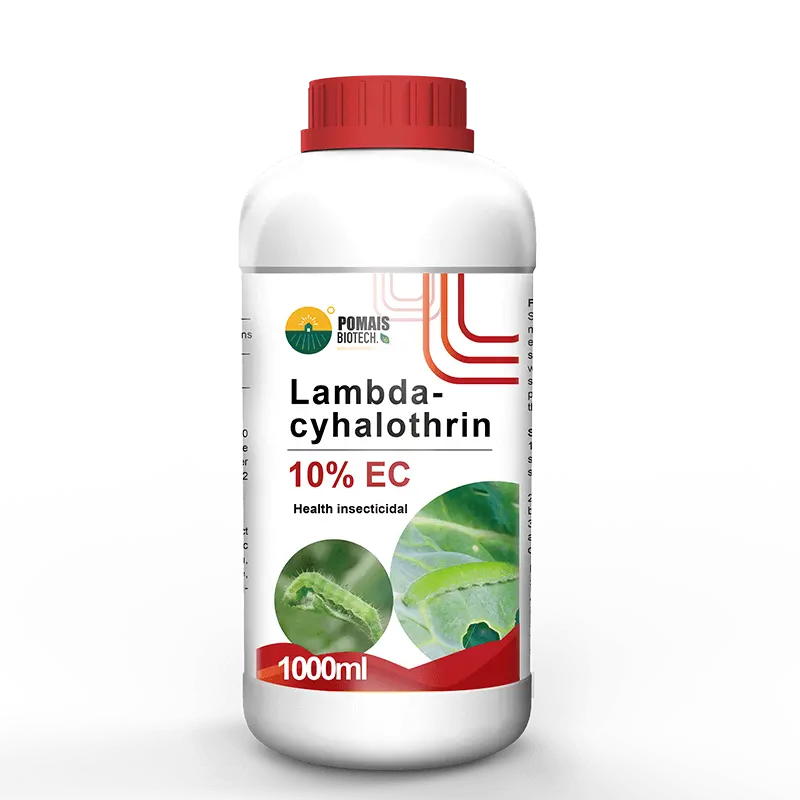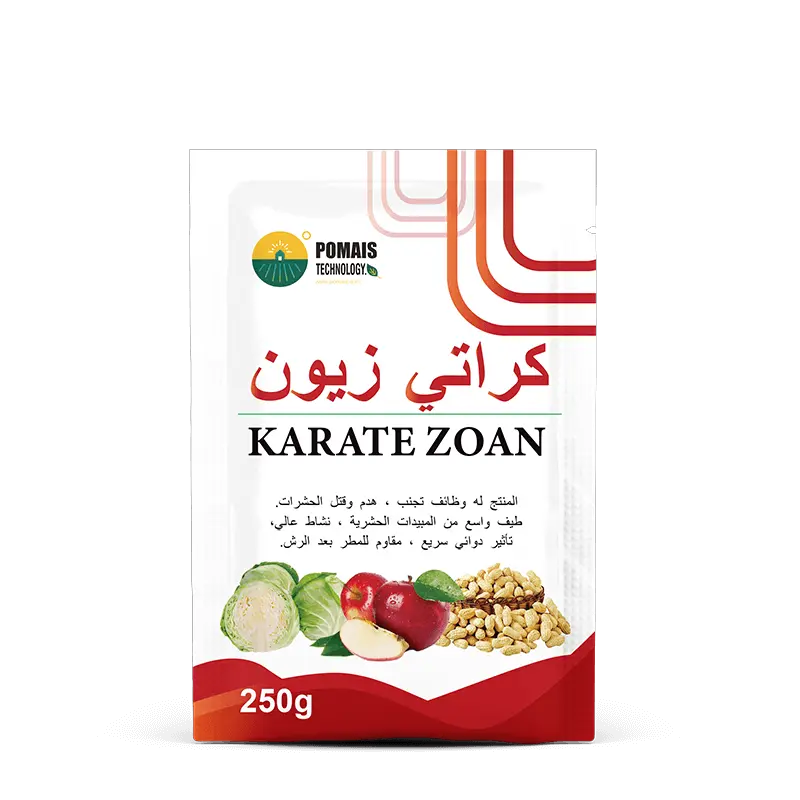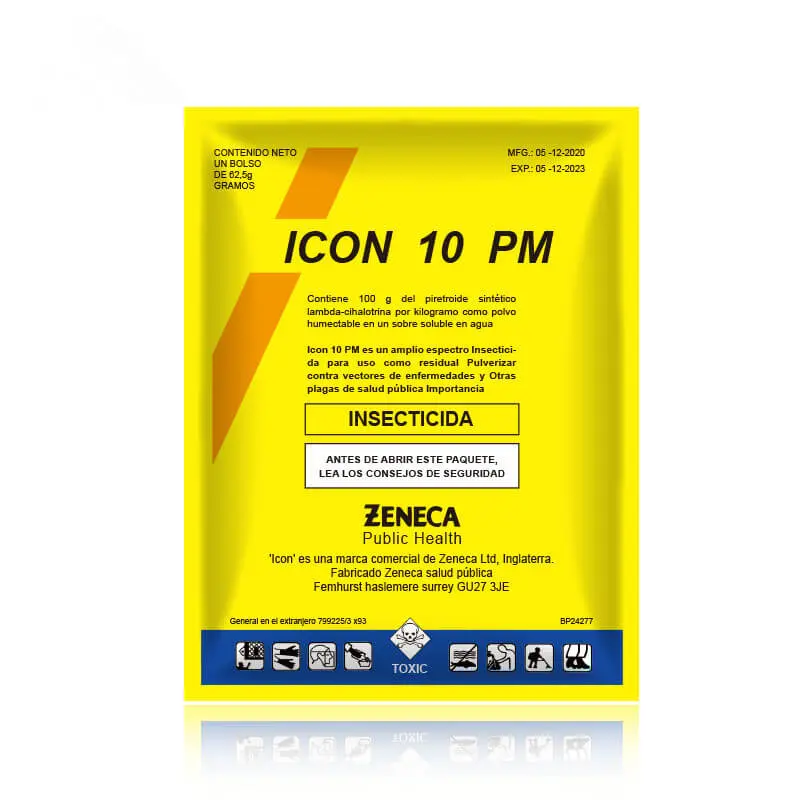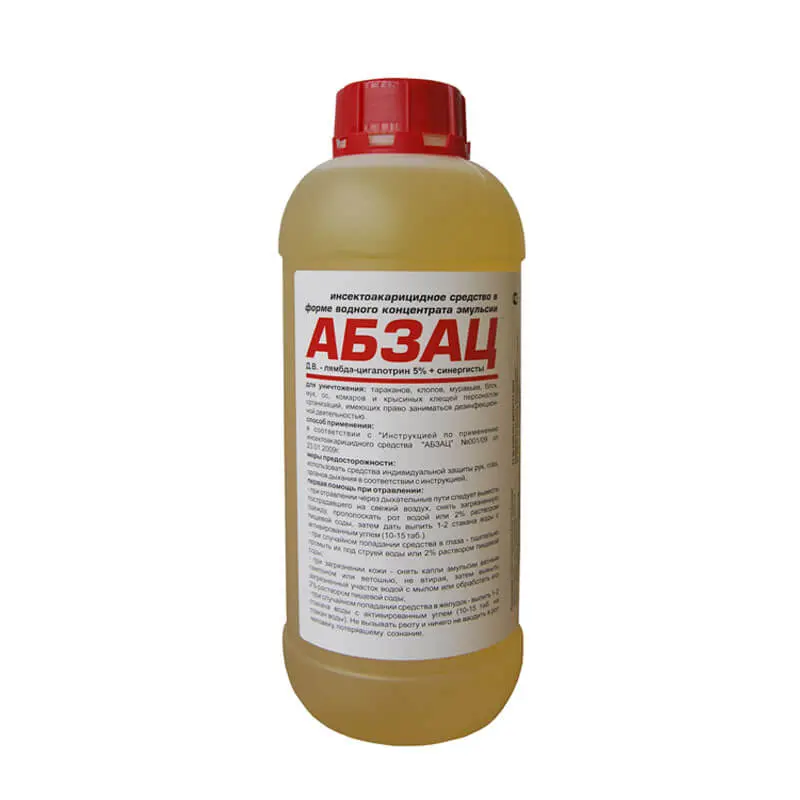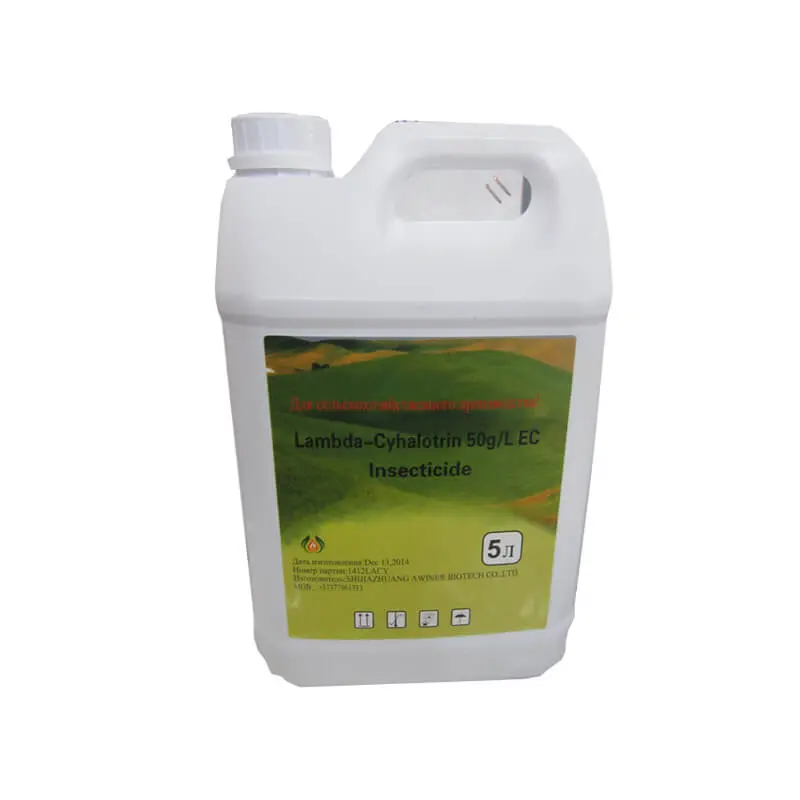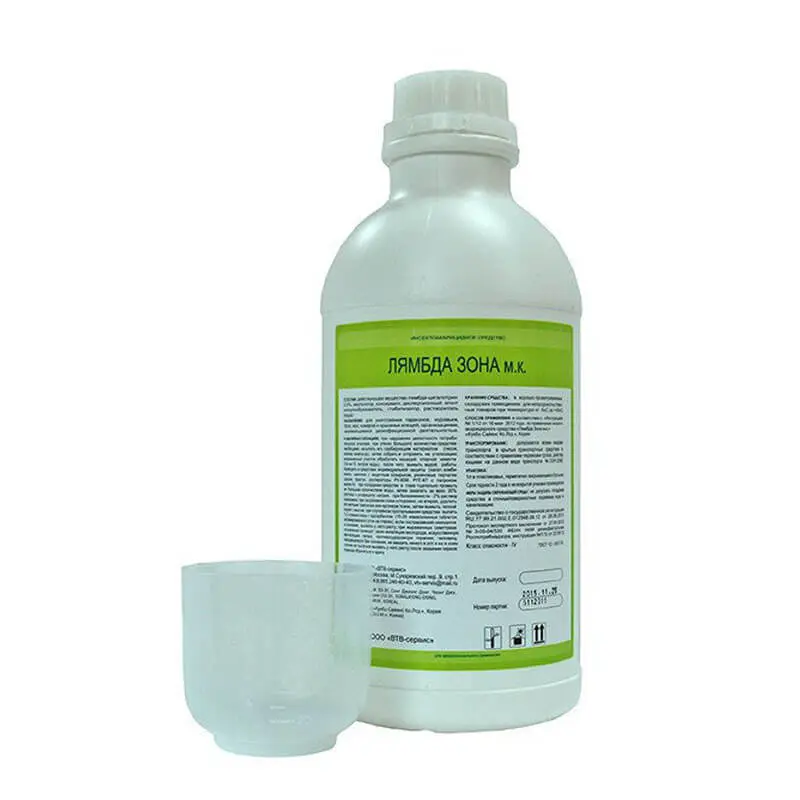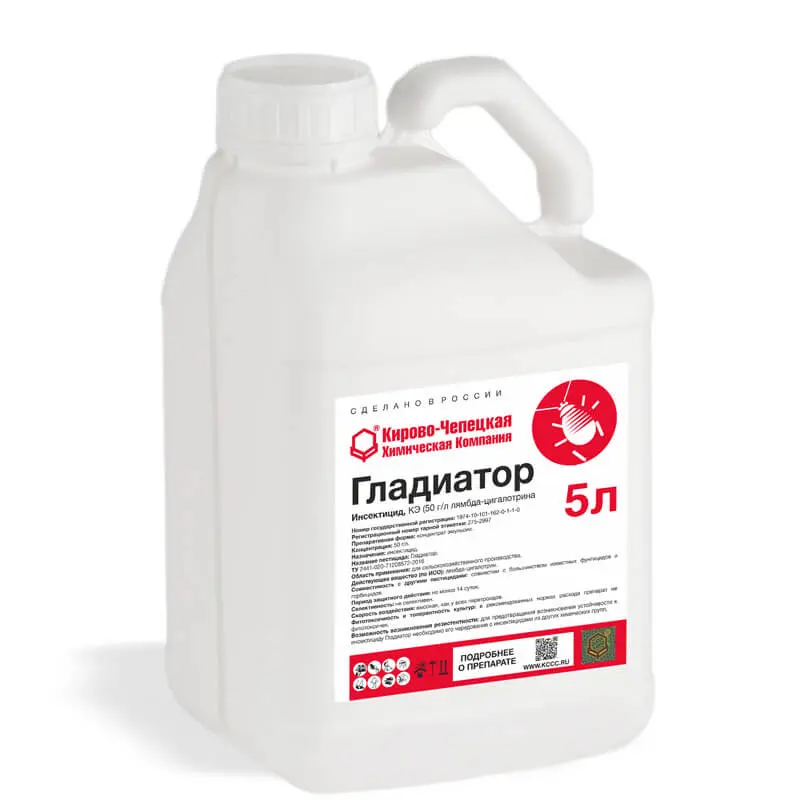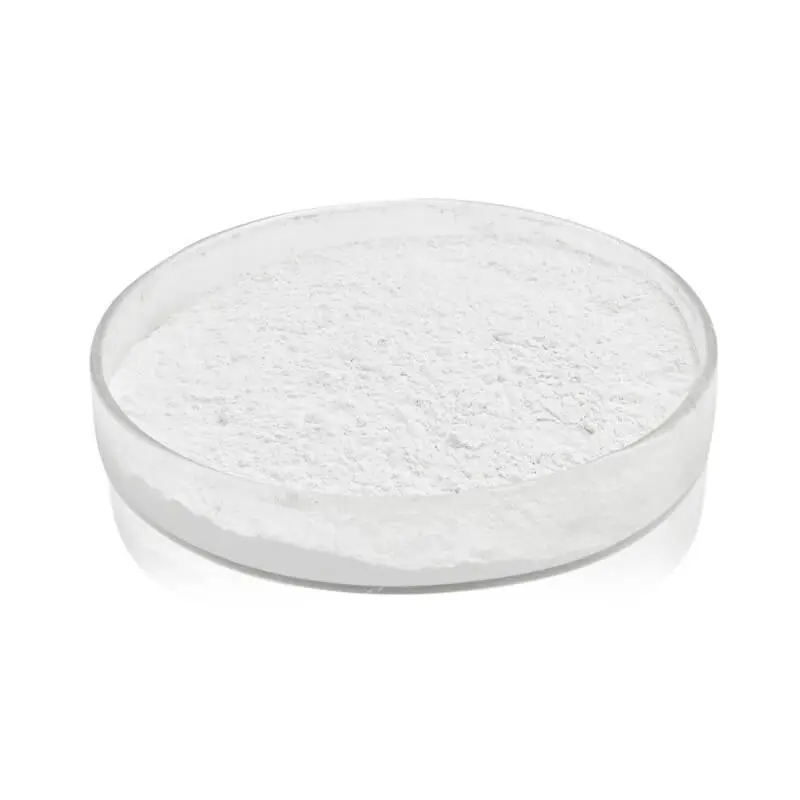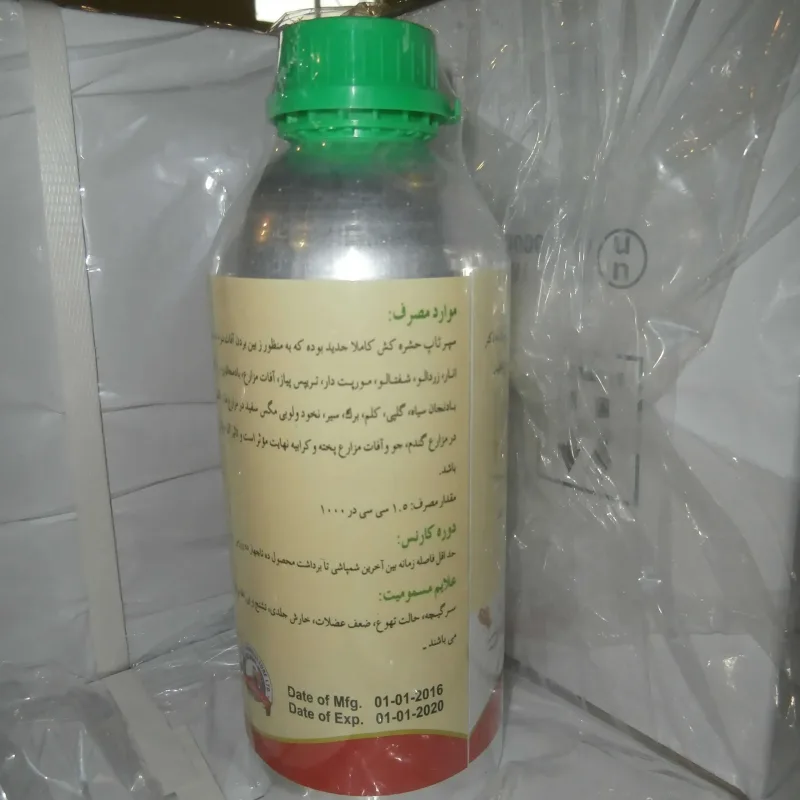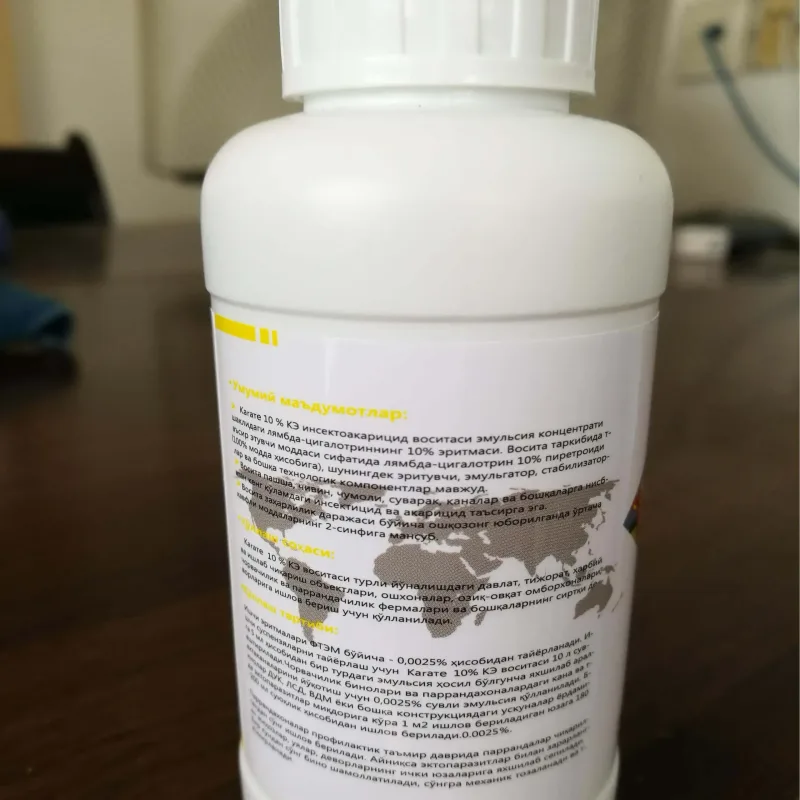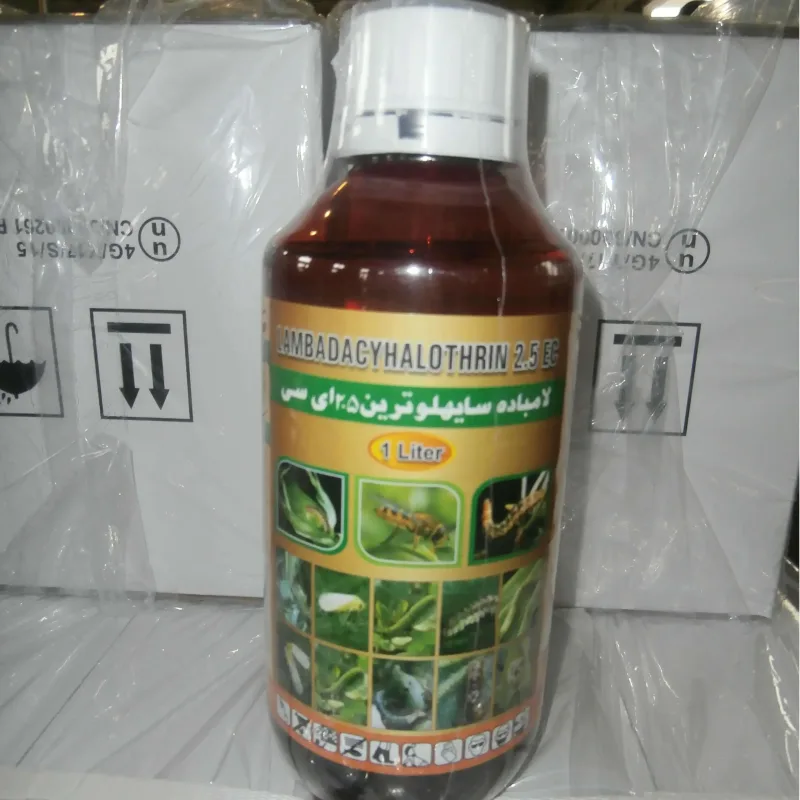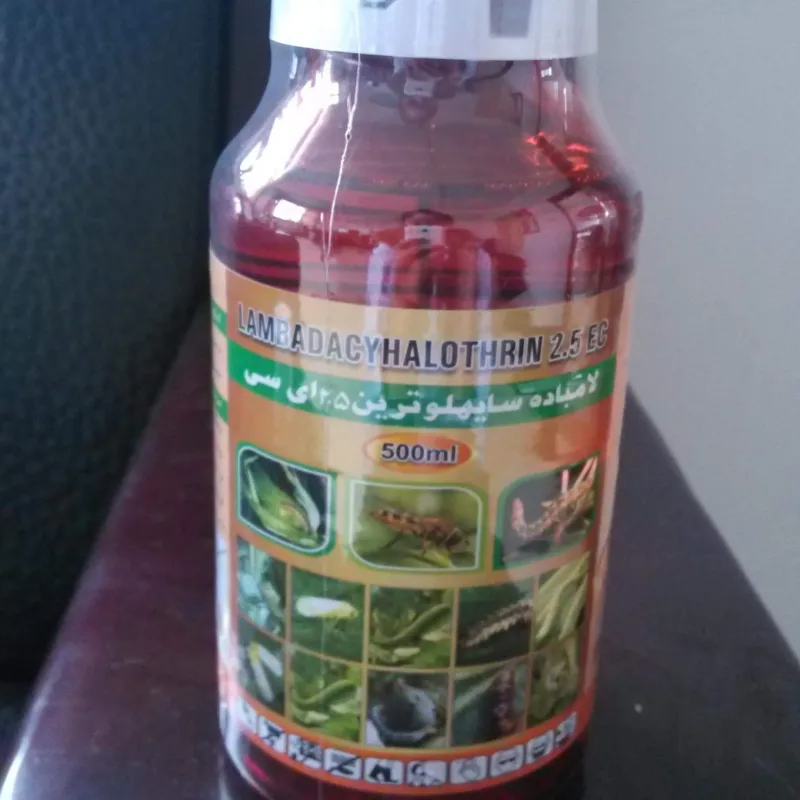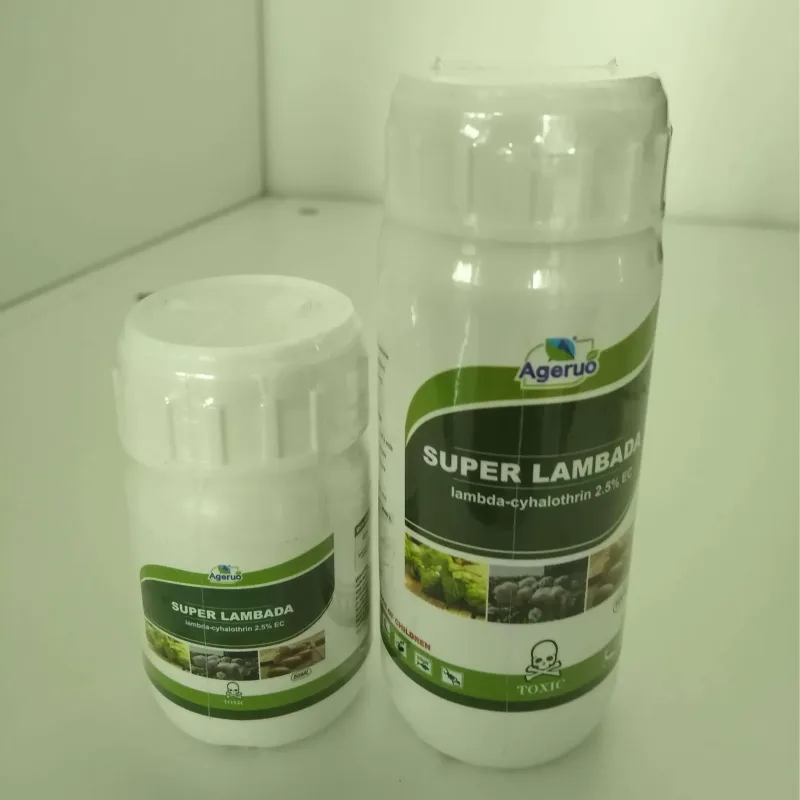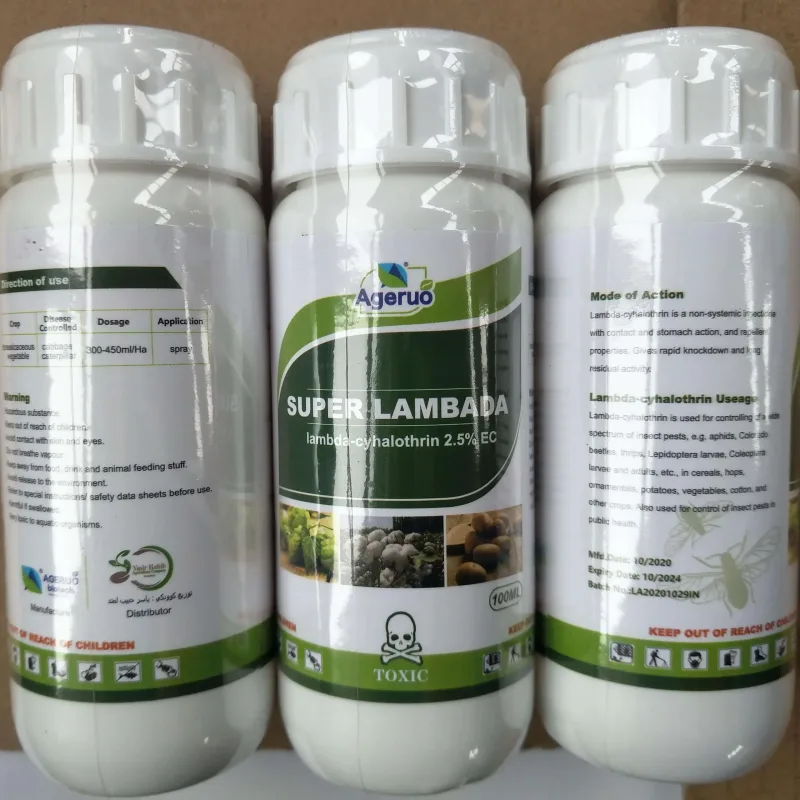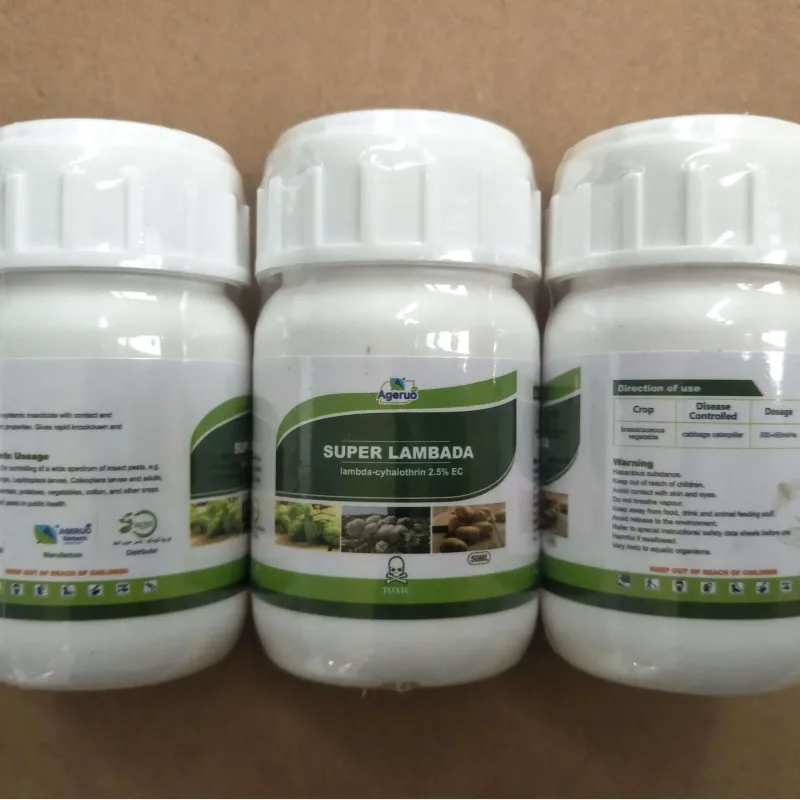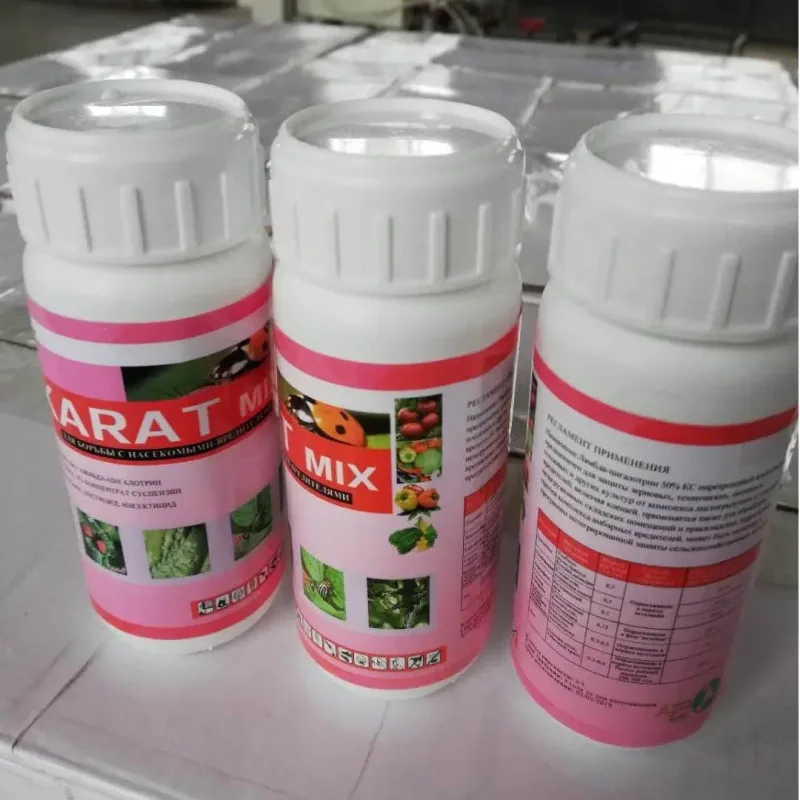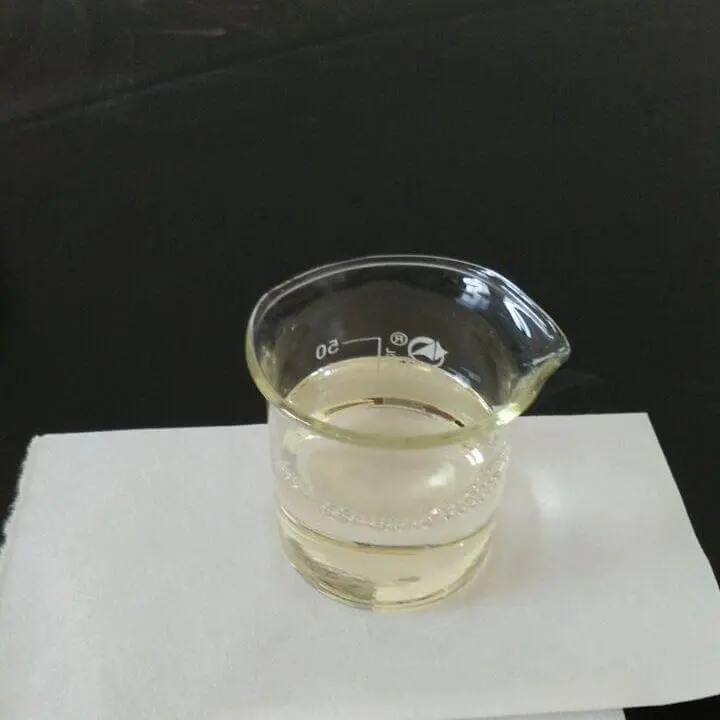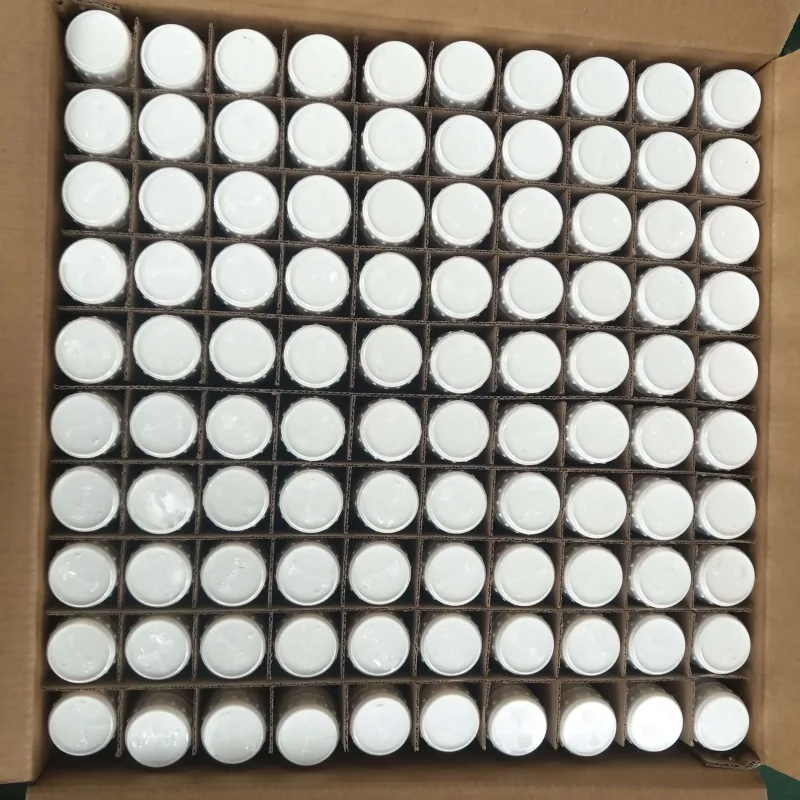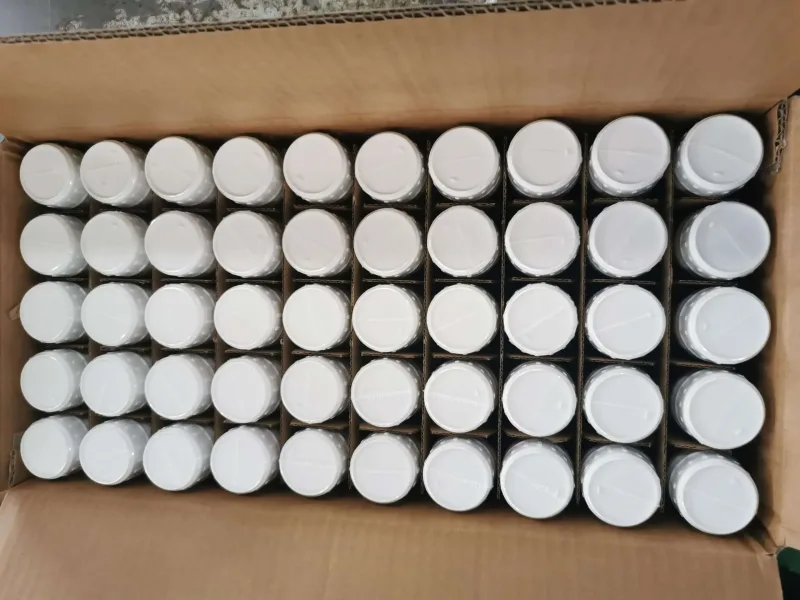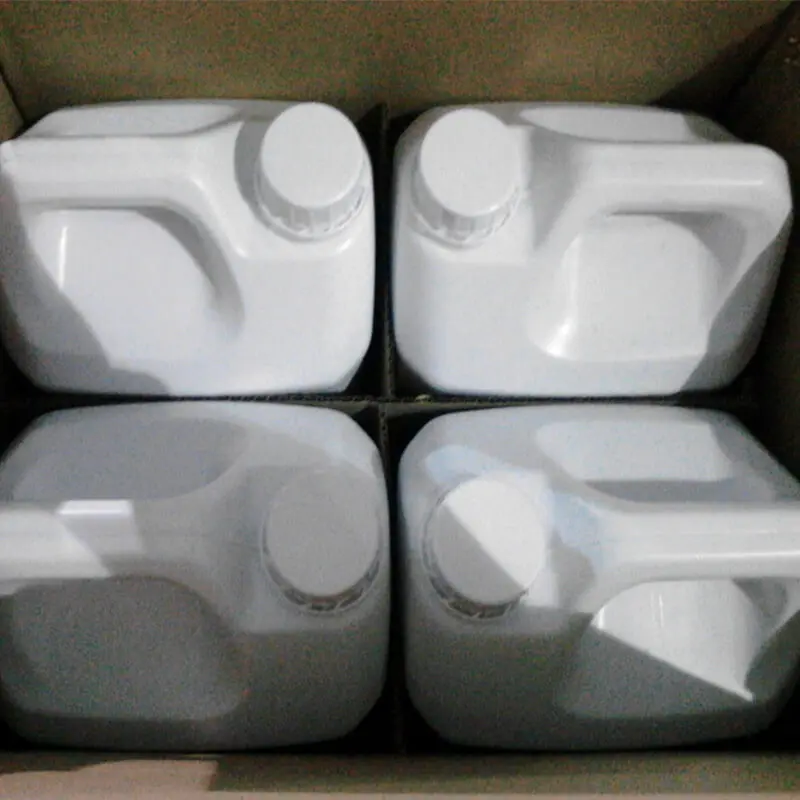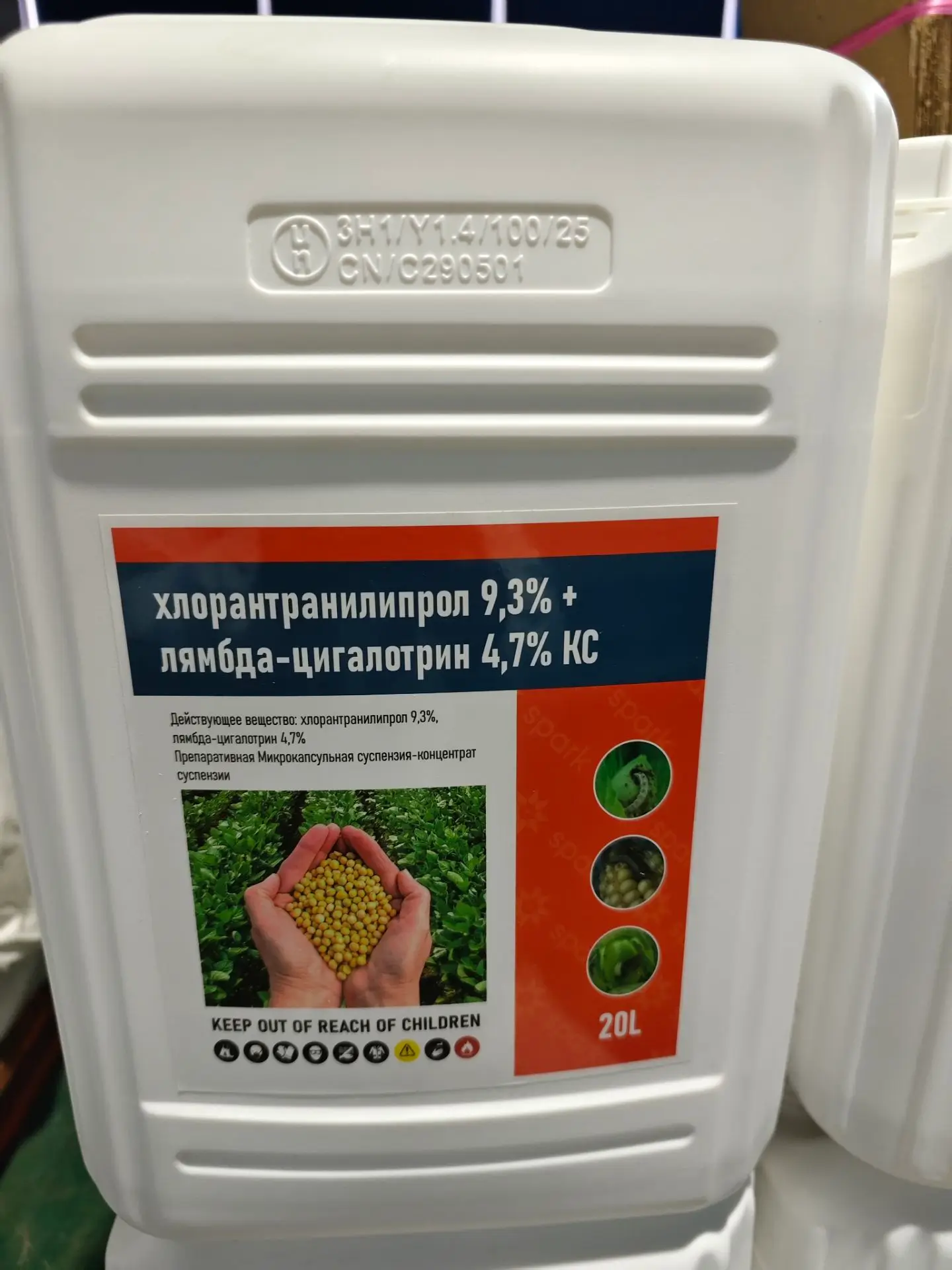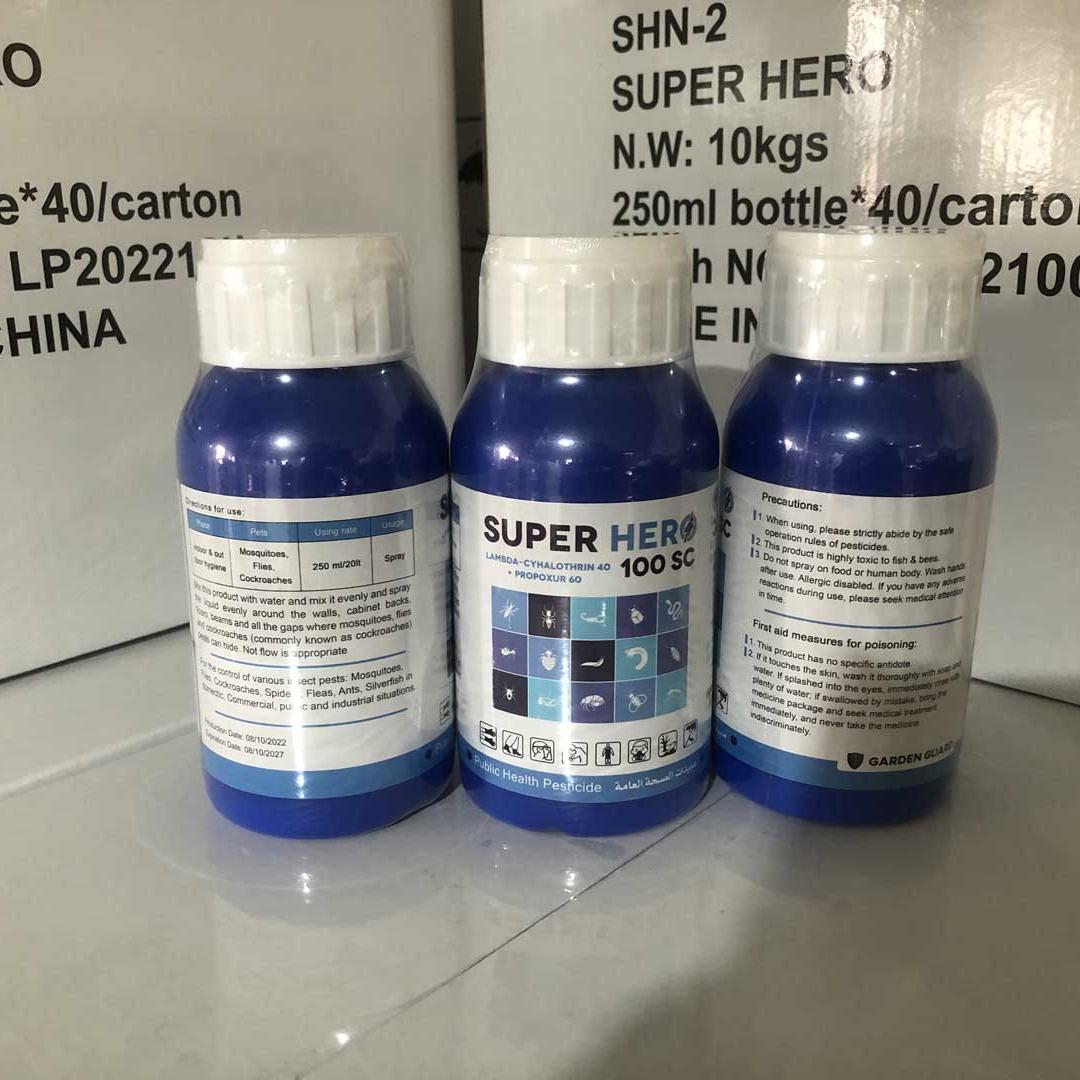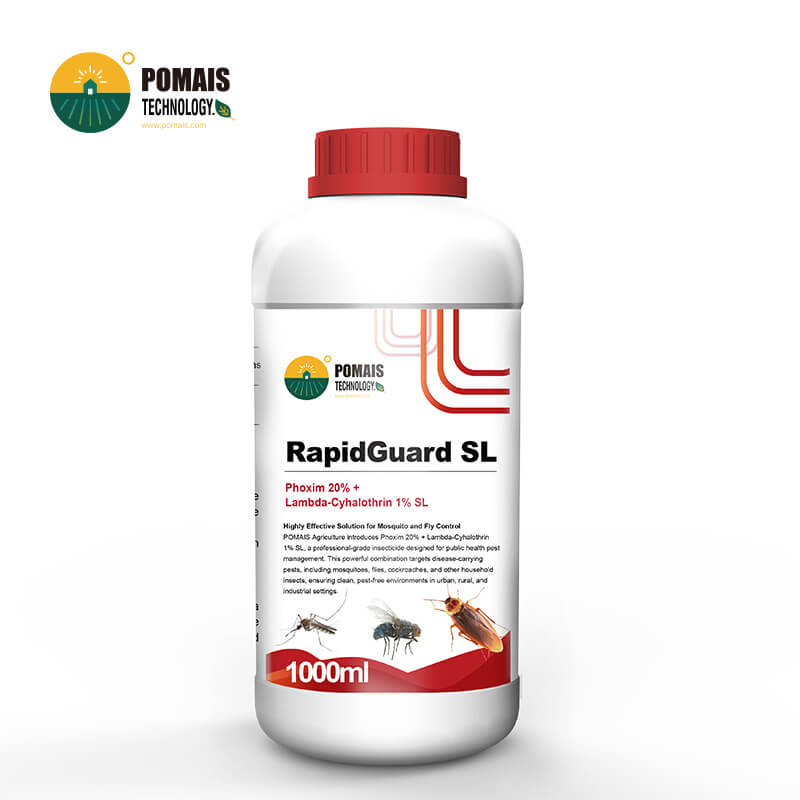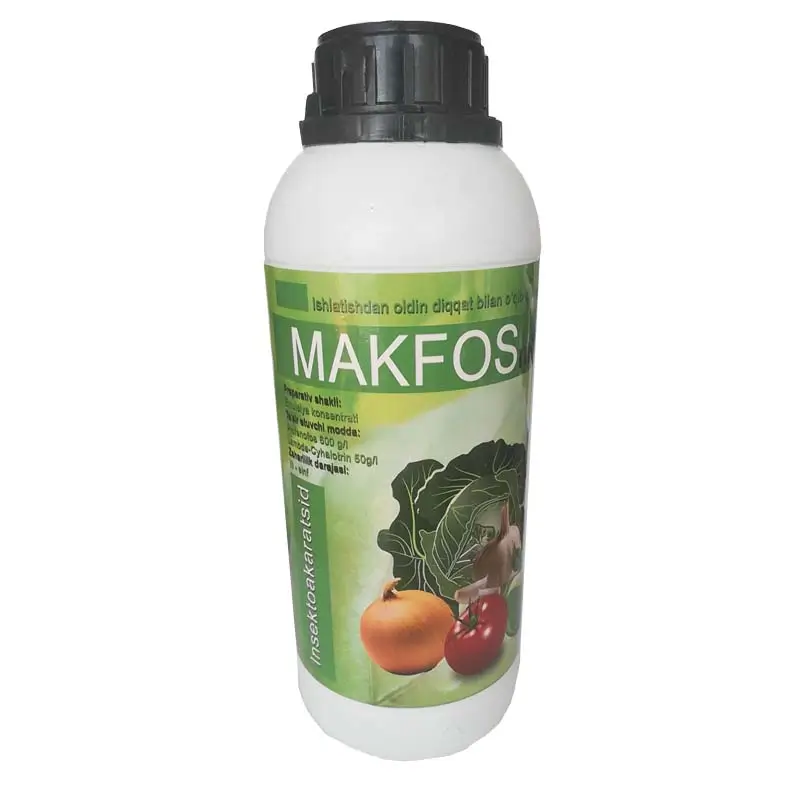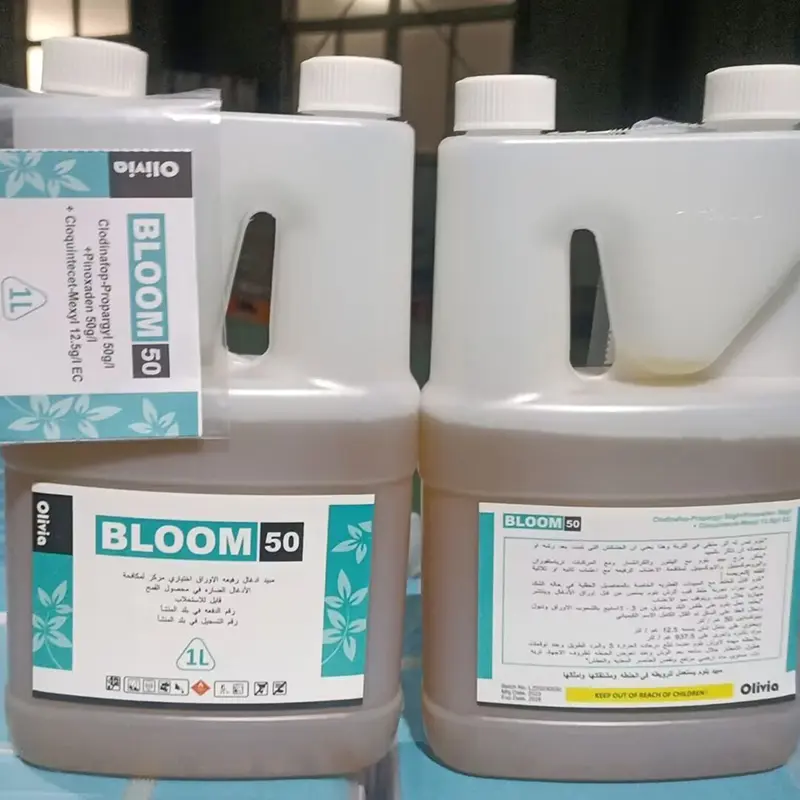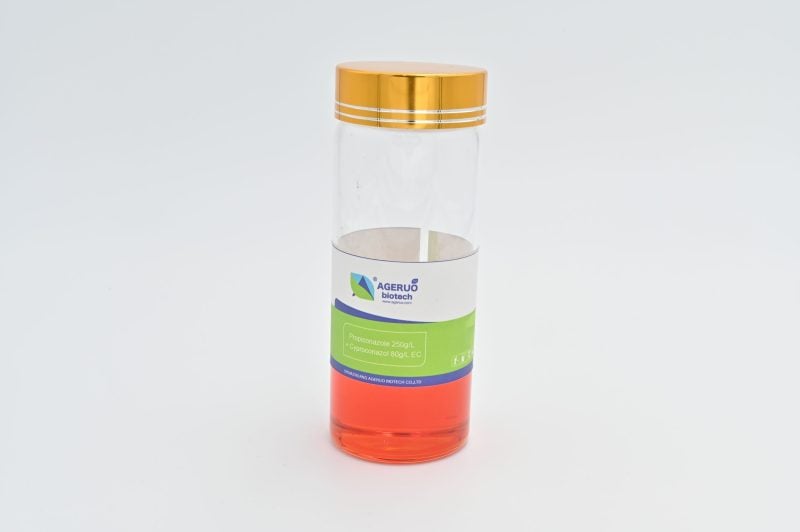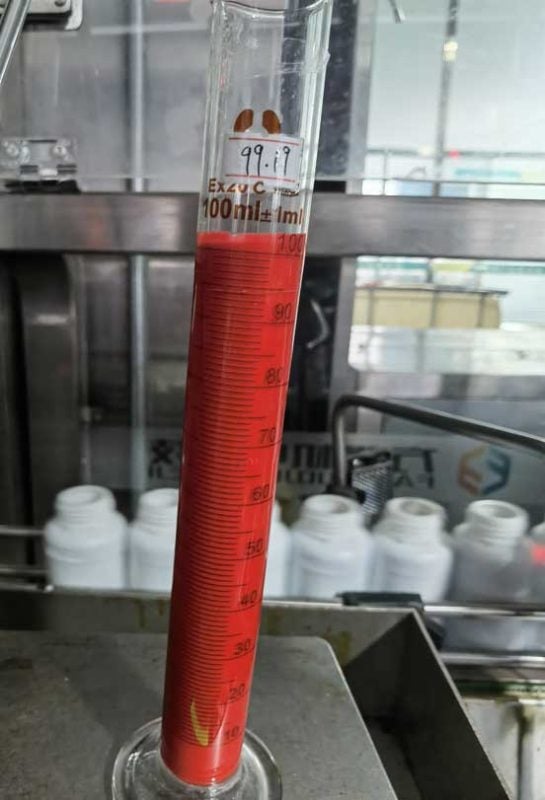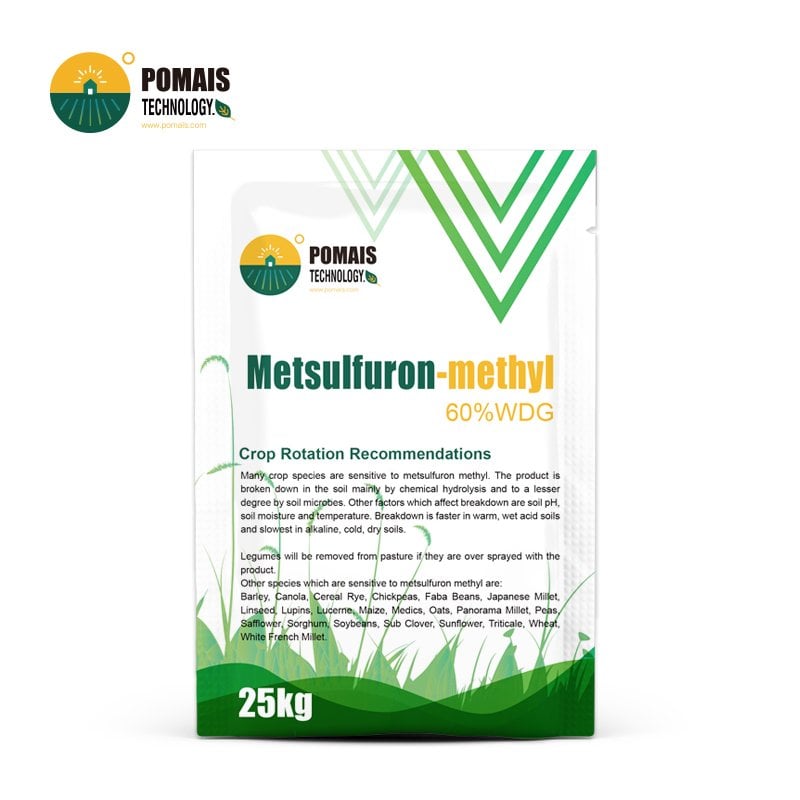Lambda-Cyhalothrin Insecticide 25g/l EC, 10%WP, 25%WP
Fast, Reliable, and Broad-Spectrum Pest Control
Protect your high-value crops with Lambda-Cyhalothrin, a premium pyrethroid insecticide trusted by growers worldwide for its fast knockdown, long-lasting residual effect, and broad-spectrum pest control. Whether you’re managing cotton bollworms, rice planthoppers, or vegetable aphids, this product delivers consistent, powerful results even under challenging weather conditions.
Available in formulations such as 2.5% EC, 5% EC, 10% WP, 25% WP, and 9.7% CS, Lambda-Cyhalothrin is tailored to suit a wide range of crops, climates, and application methods.
- Highly effective on sucking and chewing pests
- Rainfast within 1 hour of application
- Suitable for cereals, fruits, vegetables, cotton, turf, and more
- Ideal for resistance management programs
- Backed by OEM support and global registration experience
Let POMAIS help you deliver better harvests and stronger brands in your market.
- Designed for Professional Buyers & Bulk Orders
- This product is available for business purchase and large-scale distribution.
- We support custom packaging, labeling, and formulation to meet your market needs.
- Let’s build your brand together.

About Lambda-Cyhalothrin Insecticide 25g/l EC, 10%WP, 25%WP
About Lambda-Cyhalothrin Insecticide 25g/l EC, 10%WP, 25%WP
| Product Name | Lambda-Cyhalothrin Insecticide |
| CAS Number | 91465-08-6 |
| Chemical Formula | C23H19ClF3NO3 |
| Formulations Available | 2.5% EC, 5% EC, 10% WP, 25% WP, 4.9% CS, 9.7% CS |
| Target Pests | Aphids, whiteflies, beetles, caterpillars, mosquitoes |
| Mode of Action | Pyrethroid insecticide affecting the nervous system |
| Toxicity | Moderate toxicity to mammals, highly toxic to bees |
| Environmental Impact | Toxic to fish and aquatic organisms |
| Recommended Dosage | 50-100 mL/ha (for 2.5% EC formulation) |
| Application Method | Foliar spray, seed treatment |
| Storage | Store in a cool, dry place away from heat and moisture |
| Shelf Life | 2-3 years |
| Pre-Harvest Interval | 7-14 days (depending on crop) |
| Safety Precautions | Use protective equipment (gloves, mask, goggles) |
| Packaging | Various sizes available (100mL, 1L, 5L, etc.) |
Lambda-Cyhalothrin Insecticide – Fast, Reliable, and Broad-Spectrum Pest Control
Lambda-Cyhalothrin is a next-generation synthetic pyrethroid insecticide developed to offer powerful control against a wide spectrum of agricultural pests. Engineered with dual contact and stomach action, it rapidly paralyzes and eliminates pests, including aphids, whiteflies, thrips, caterpillars, and bollworms—minimizing crop loss and boosting productivity.
Its systemic-like movement and strong adherence to plant surfaces enable extended protection, even after rainfall or sunlight exposure. Lambda-Cyhalothrin is especially suited for integrated pest management (IPM) systems, offering both curative and preventive value across various growth stages of crops.
Mode of Action
Lambda-Cyhalothrin functions by targeting the voltage-gated sodium channels in the nerve cells of insects. Upon contact or ingestion, it disrupts the normal function of these channels, causing prolonged depolarization of the nerve membrane. This leads to:
- Uncontrolled nerve firing
- Hyperexcitation of muscles
- Rapid paralysis
- Eventual death of the insect
As a non-systemic insecticide with contact and stomach toxicity, it acts quickly after application, often showing visible pest knockdown within minutes. The compound adheres strongly to plant surfaces, ensuring prolonged residual activity without systemic movement inside the plant.
Key Characteristics of Its Action:
- Dual action: Both contact and ingestion pathways
- Fast knockdown: Effective within hours of application
- Selective toxicity: Targets insect pests with minimal effect on crops
- UV stability: Maintains performance under field sunlight exposure
Because of its mode of action, Lambda-Cyhalothrin is particularly valuable in resistance management programs. When rotated with insecticides of different classes (e.g., neonicotinoids, organophosphates), it helps delay the onset of pest resistance in intensive cropping systems.
Key Product Benefits
1. Rapid Knockdown and Broad-Spectrum Control
Lambda-Cyhalothrin delivers fast-acting results through both contact and stomach action, effectively targeting a wide range of chewing and sucking insects. From bollworms in cotton to leafhoppers in rice, it offers one solution for multiple pest pressures.
2. Long Residual Activity with Rainfast Properties
Thanks to its high affinity to leaf surfaces and translaminar movement, Lambda-Cyhalothrin remains active even after light to moderate rainfall. This extended protection reduces the need for repeat applications and lowers operational costs.
3. Selective Safety to Crops
While highly lethal to target insects, Lambda-Cyhalothrin demonstrates low phytotoxicity, making it safe for use across cereals, vegetables, fruit trees, and industrial crops when applied at recommended rates. Its selectivity also supports integration with other crop protection tools.
4. Low Use Rate and High Potency
With effective performance at dosages as low as 150–300 mL/ha, Lambda-Cyhalothrin ensures maximum efficiency with minimal input. This supports cost-effective pest control, especially for large-scale operations.
5. Compatibility with IPM Programs
Lambda-Cyhalothrin is compatible with many Integrated Pest Management (IPM) programs. It may be rotated with or tank-mixed with other insecticides or fungicides to minimize resistance and broaden pest spectrum control.
6. Multiple Formulations for Versatile Use
Available in EC, WP, CS, and granular formulations, it is adaptable for different application methods, climates, and market preferences. POMAIS offers full OEM/ODM support to meet localized agricultural needs.
Target Pests & Application Scenarios
Lambda-Cyhalothrin is a broad-spectrum insecticide effective against a wide range of chewing and sucking pests across field crops, vegetables, fruits, and public health settings. It is especially effective against:
Key Target Pests:
- Lepidoptera: Cotton bollworms, armyworms, cutworms, leafrollers
- Hemiptera: Aphids, whiteflies, planthoppers
- Coleoptera: Flea beetles, weevils
- Diptera: Mosquitoes, flies
- Thysanoptera: Thrips
- Mites: Red spider mites (when combined with compatible acaricides)
Crop-Specific Application Scenarios:
| Crop Category | Typical Target Pests | Application Stage |
|---|---|---|
| Cereal Crops | Aphids, armyworms, leafhoppers | Tillering to flowering |
| Rice Fields | Brown planthopper, rice leaf folder, rice weevil | Active vegetative and heading stage |
| Cotton | Cotton bollworm, red spider mite, aphids | From squaring to boll development |
| Vegetables | Thrips, aphids, cabbage worms, beet armyworm | Seedling to fruiting |
| Fruits (Citrus, Apple, Grape) | Psyllids, whiteflies, mites, moth larvae | Pre-bloom and post-fruit set |
| Tea and Tobacco | Leafhoppers, cutworms | Leaf expansion and early harvest |
| Ornamentals & Turf | Aphids, thrips, whiteflies | At pest emergence |
| Public Health | Mosquitoes, flies, cockroaches | Household & livestock environments |
Lambda-Cyhalothrin is also suitable for use in non-crop settings, such as warehouses, livestock shelters, and along roadsides, where vector or nuisance insect populations require control.
Crop-Specific Pest Control Applications with Lambda-Cyhalothrin
Lambda-Cyhalothrin is a powerful synthetic pyrethroid insecticide designed to deliver broad-spectrum protection across a wide range of crops. Known for its rapid knockdown and long residual activity, it effectively targets sucking and chewing pests, including aphids, whiteflies, armyworms, and various Lepidoptera species. Below is an in-depth breakdown of how this active ingredient serves different agricultural sectors with tailored formulations and pest-specific control.
1. Cereal Crops – Reliable Protection Against Major Field Pests
Cereal crops are highly vulnerable to both sap-feeding and defoliating pests. Lambda-Cyhalothrin delivers immediate protection with fast contact and stomach action, ensuring yield security during critical growth stages.
| Crop | Target Pests | Recommended Formulations |
|---|---|---|
| Wheat | Aphids, Leafhoppers, Armyworms, Red Mites | 2.5% EC, 5% EC, 10% WP |
| Corn (Maize) | Corn Borer, Fall Armyworm, Thrips | 2.5% EC, 5% EC |
| Barley | Aphids, Leafhoppers | 2.5% EC, 25% WP |
Use during early pest emergence to minimize leaf loss and viral transmission risk.
2. Rice Farming – Targeting Planthoppers and Folders with Precision
Rice is prone to brown planthopper infestations, which can devastate yields. Lambda-Cyhalothrin works as an essential part of IPM in paddy fields, offering strong knockdown while maintaining crop safety.
| Crop | Target Pests | Recommended Formulations |
|---|---|---|
| Rice | Brown Planthopper, Rice Leaf Folder, Rice Weevil | 2.5% EC, 10% WP, 4.9% CS |
Apply at tillering and panicle initiation stages for optimal efficacy against sap feeders and defoliators.
3. Cash Crops – Ensuring High-Value Crop Protection
High-value crops such as cotton and tobacco require sustained insect control due to longer growing cycles. Lambda-Cyhalothrin offers systemic-like coverage through foliar application with strong adherence and penetration.
| Crop | Target Pests | Recommended Formulations |
|---|---|---|
| Cotton | Cotton Bollworm, Red Spider Mites, Aphids | 5% EC, 10% WP, 9.7% CS |
| Tobacco | Tobacco Budworm, Spodoptera litura | 2.5% EC, 5% EC |
| Rapeseed (Canola) | Mustard Aphids, Cabbage Butterfly | 2.5% EC, 5% EC |
Ideal for use in resistance management programs and crop quality assurance.
4. Fruit Orchards – Targeted Sprays for Delicate Crops
Fruit-bearing trees are highly sensitive to pest infestations. Lambda-Cyhalothrin’s low phytotoxicity and broad efficacy make it an ideal choice for foliar spraying in orchards and vineyard systems.
| Crop | Target Pests | Recommended Formulations |
|---|---|---|
| Citrus (Orange, Lemon, Grapefruit) | Citrus Whitefly, Asian Citrus Psyllid | 5% EC, 9.7% CS |
| Apple | Apple Moth, Mites | 2.5% EC, 5% EC |
| Grapes | Grape Leaf Folder, Leafhoppers | 2.5% EC, 4.9% CS |
Can be used in rotation with other actives to avoid pest resurgence and maintain export quality.
5. Vegetable Crops – Rapid Control for Leaf and Fruit Pests
Vegetable farming faces aggressive pest pressure throughout the season. Lambda-Cyhalothrin acts quickly to protect tender crops while preserving fruit appearance and market value.
| Crop | Target Pests | Recommended Formulations |
|---|---|---|
| Tomato | Whiteflies, Aphids, Spodoptera litura | 2.5% EC, 5% EC, 10% WP |
| Chili/Pepper | Beet Armyworm, Thrips | 2.5% EC, 5% EC |
| Cabbage | Diamondback Moth, Aphids | 2.5% EC, 5% EC |
| Cucumber | Aphids, Whiteflies | 2.5% EC, 5% EC |
| Potato | Potato Beetle, Aphids | 2.5% EC, 5% EC |
Recommended for spraying during early vegetative growth to reduce pest establishment.
6. Turf & Ornamentals – Aesthetic Crop Preservation
For landscaping, nurseries, and turf management, Lambda-Cyhalothrin offers fast-acting control without causing damage to grass or ornamental foliage.
| Application | Target Pests | Recommended Formulations |
|---|---|---|
| Lawn & Turfgrass | Soil Insects, Grasshoppers, Aphids | Granular, 2.5% EC |
| Ornamental Plants | Aphids, Whiteflies, Thrips | 2.5% EC, 5% EC |
Can be safely used around public areas with proper post-application intervals.
7. Public Health & Veterinary Applications – Broad-Spectrum Pest Control
Beyond agriculture, Lambda-Cyhalothrin also serves in vector control for public health and animal husbandry sectors, offering long-lasting surface residual activity.
| Application | Target Pests | Recommended Formulations |
|---|---|---|
| Household & Storage Areas | Cockroaches, Mosquitoes, Flies | 2.5% EC, 5% EC |
| Livestock & Poultry Facilities | Stable Flies, Cattle Lice, Fleas | 5% EC, 9.7% CS |
Ideal for fogging, surface spraying, or animal shelter disinfection routines.
Usage Methods & Recommended Dosage
Lambda-Cyhalothrin is applied primarily through foliar spraying, but may also be used in seed treatments or soil surface applications depending on the crop and pest pressure. Precision in timing and dosage is essential for optimal results and residue management.
Application Methods:
- Foliar Spray: Most common method for field crops, fruits, vegetables, and public health uses.
- Soil Surface Spray: For crawling pests in turf or near root zones.
- Seed Treatment: In selected crops to prevent early-stage insect damage.
Recommended Dosage by Crop and Pest:
| Crop | Target Pests | Recommended Dosage | Formulation Example |
|---|---|---|---|
| Cotton | Bollworms, aphids, red mites | 300–450 mL/ha | 5% EC, 9.7% CS |
| Rice | Planthoppers, rice leaf folder | 200–300 mL/ha | 2.5% EC, 10% WP |
| Wheat | Aphids, leafhoppers | 150–225 mL/ha | 2.5% EC |
| Cabbage | Diamondback moth, aphids | 150–225 mL/ha | 5% EC |
| Tomato | Whiteflies, spodoptera, thrips | 200–300 mL/ha | 5% EC, 10% WP |
| Apple | Leafrollers, mites | 200–300 mL/ha | 2.5% EC |
| Tea Trees | Leafhoppers, aphids | 300–600 mL/ha | 2.5% EC, 5% EC |
| Tobacco | Cutworms, spodoptera | 115–150 mL/ha | 2.5% EC |
| Grapes | Leafhoppers, leaf folders | 200–300 mL/ha | 4.9% CS |
| Public Health | Mosquitoes, flies, cockroaches | 10–25 mL/10 L water (indoor) | 2.5% EC |
Note: Always refer to your country’s registration label for precise local use recommendations, and observe re-entry and pre-harvest intervals strictly.
Rainfastness & Environmental Impact
Rainfastness and Field Durability
Lambda-Cyhalothrin is engineered for high adhesion and strong lipophilicity, allowing it to bind quickly to plant surfaces. This feature grants it excellent rainfastness, with protection maintained even after rainfall occurring 1–2 hours post-application. For farmers in regions prone to sudden showers, this ensures reliable pest control without the need to reapply, reducing labor and chemical waste.
Field trials confirm that Lambda-Cyhalothrin retains its efficacy for 7 to 14 days after application under normal field conditions, depending on pest pressure, crop type, and formulation used. Its microencapsulated CS forms offer even longer-lasting protection, ideal for extended pest emergence cycles.
Environmental Considerations
While Lambda-Cyhalothrin is moderately toxic to mammals and low in soil persistence, it is highly toxic to aquatic organisms and bees. Therefore, its use must be carefully managed near water bodies, and application should be avoided during peak pollinator activity.
To support sustainable agriculture:
- Always apply in calm weather to minimize drift.
- Avoid spraying blooming crops when bees are actively foraging.
- Follow all local regulations on buffer zones and aquatic safety.
POMAIS offers eco-compliant formulations and guidance for safe application, helping distributors and large farms balance effective pest control with environmental responsibility.
Is Lambda-Cyhalothrin Safe for Pets and Non-Target Organisms?
Lambda-Cyhalothrin is classified as moderately toxic to mammals but has a low toxicity profile when used as directed, making it relatively safe for use in residential and horticultural environments where pets may be present. However, certain precautions must be observed to ensure the safety of household animals such as dogs, cats, rabbits, and birds:
- Avoid Direct Contact During Application: Pets should be kept away from the treatment area during and immediately after spraying. This includes lawns, vegetable gardens, orchards, or decorative plants that have been treated.
- Re-Entry Time: It is generally safe to allow pets back into the treated area once the spray has completely dried—typically after 2 to 4 hours, depending on weather and humidity conditions.
- Residue Consideration: Although Lambda-Cyhalothrin binds well to plant surfaces and soils, minimizing runoff, licking of freshly treated leaves or surfaces by pets should be prevented during the immediate post-application period.
- Aquatic Risk Warning: This insecticide is highly toxic to aquatic organisms, including fish and amphibians. Special care should be taken to avoid drift or runoff into ponds, aquariums, or open water systems near application zones.
When applied at the recommended rates and intervals, Lambda-Cyhalothrin is safe for plants and will not cause phytotoxic effects. It is commonly used in edible crop settings, including vegetables, fruit trees, and herbs, underscoring its safety profile under good agricultural practices (GAP).
Tank Mix Compatibility & IPM Role
Tank Mix Compatibility
Lambda-Cyhalothrin is highly compatible with a wide range of agrochemical products, offering you flexibility in integrated pest control strategies:
- Compatible Products:
- Systemic insecticides such as imidacloprid, thiamethoxam, and acetamiprid, which complement Lambda-Cyhalothrin’s contact action with root-to-leaf systemic protection.
- Fungicides like mancozeb, tebuconazole, and azoxystrobin to protect against concurrent fungal infections.
- Herbicides such as glyphosate and 2,4-D for pre-plant or inter-row applications in compatible crops.
- Mixing Guidelines:
- Always perform a jar test before large-scale mixing.
- Use compatible adjuvants or surfactants to enhance adhesion and rainfastness.
- Follow recommended pH range (5.5–7.5) to maintain formulation stability.
By using Lambda-Cyhalothrin in tank mixes, you reduce the number of field passes, saving both time and application costs while broadening your pest control spectrum.
Role in IPM (Integrated Pest Management)
Lambda-Cyhalothrin plays a vital role in sustainable crop protection programs, especially when used strategically within an Integrated Pest Management (IPM) framework:
- Rotation Strategy:
- As a Group 3A insecticide (IRAC classification), it should be rotated with products from different mode-of-action groups to delay resistance development.
- Alternating Lambda-Cyhalothrin with neonicotinoids, organophosphates, or biopesticides can enhance long-term control efficacy.
- Threshold-Based Application:
- Apply only when pest populations exceed economic threshold levels, minimizing non-target impact and preserving beneficial insects.
- Scouting and monitoring tools (pheromone traps, sticky cards) should guide timing of sprays.
- Targeted Application Windows:
- Use Lambda-Cyhalothrin during early pest outbreaks or peak larval stages for rapid knockdown and prevention of feeding damage.
- In protected cropping or high-value cash crops, it serves as an emergency response tool when natural controls are insufficient.
By integrating Lambda-Cyhalothrin into your tank mix routines and IPM plans, you gain greater operational efficiency, consistent yield protection, and alignment with modern sustainable agriculture practices.
Lambda-Cyhalothrin Mixed Formulations – Enhanced Spectrum & Resistance Management
To meet the evolving demands of integrated pest management (IPM) and combat growing resistance concerns, POMAIS offers formulated combinations of Lambda-Cyhalothrin with other insecticidal active ingredients, each selected for its complementary mode of action and target pest coverage. These premixed solutions enhance pest control efficacy and reduce overreliance on single actives.
Key Lambda-Cyhalothrin Combination Products:
- Lambda-Cyhalothrin 2% + Clothianidin 6% SC
- Mode of Action: Pyrethroid (nerve action) + Neonicotinoid (nicotinic receptor disruption)
- Benefits: Ideal for soil-dwelling and sap-feeding pests; delivers both contact and systemic activity.
- Use Cases: Effective in rice, sugarcane, cotton, and vegetable crops to control planthoppers, whiteflies, and cutworms.
- Lambda-Cyhalothrin 9.4% + Thiamethoxam 12.6% SC
- Mode of Action: Dual-action formula combining fast knockdown with long-lasting residual control.
- Benefits: Particularly effective in high-pressure environments with resistant aphid and leafhopper populations.
- Use Cases: Recommended for soybean, wheat, citrus, and chili protection.
- Lambda-Cyhalothrin 4% + Imidacloprid 8% SC
- Mode of Action: Synergistic action against both adults and larvae, including hard-to-control sucking pests.
- Benefits: Delivers quick kill and translaminar activity, protecting leaf surfaces and internal tissues.
- Use Cases: Common in horticultural crops and plantation sectors, including grapes, citrus, and cucurbits.
- Lambda-Cyhalothrin 5% + Acetamiprid 20% EC
- Mode of Action: Strong systemic movement from Acetamiprid + powerful contact and repellency from Lambda-Cyhalothrin.
- Benefits: Broad pest spectrum, including thrips, aphids, flea beetles, jassids, and fruit borers.
- Use Cases: Widely adopted in cotton, tobacco, vegetables, and mango orchards.
Why Choose POMAIS Mixed Formulations?
- Efficient Field Coverage: Reduced number of sprays needed due to broader pest target range.
- Resistance Management: Alternating or combining modes of action slows the development of resistance.
- Optimized Ratios: Each combination is precisely formulated to maximize synergistic effects without increasing crop stress or phytotoxicity.
- Regulatory-Ready: All mixtures are supported with COA, MSDS, and residue data, facilitating smooth product registration in most countries.
Packaging & OEM Options
Standard Packaging Options
POMAIS offers flexible packaging formats tailored to diverse distribution and end-use scenarios. Our Lambda-Cyhalothrin insecticide is available in the following standard specifications:
- Liquid Formulations (EC, CS):
- 100 mL, 250 mL, 500 mL, 1 L, 5 L HDPE bottles
- Bulk options: 20 L, 200 L drums
- Solid Formulations (WP):
- 100 g, 250 g, 500 g, 1 kg aluminum foil pouches
- Bulk packs: 5 kg, 10 kg, 25 kg fiber drums
All containers are UN-certified, leak-proof, and designed to ensure product stability during long-haul international transport.
OEM / ODM Customization Services
To help you build a competitive brand in your market, POMAIS provides comprehensive OEM and ODM services:
- Private Label Branding
Full customization of product labels with your brand name, design language, and legal compliance per country-specific pesticide regulations. - Custom Formulation Ratios
Modify active ingredient concentration (e.g., 2.5% EC, 5% EC, 9.7% CS) or blend with other actives (e.g., imidacloprid, clothianidin) based on your local market preference. - Bottle Design and Packaging Materials
Choose from various bottle shapes, caps, seal liners, shrink wraps, outer cartons, and more. Custom molds for bottle design are available for high-volume orders. - Language and Compliance
Multilingual label printing, SDS generation, and barcode/QR code application to meet import documentation and regulatory approval in your target region.
Minimum Order & Lead Time
- MOQ: 500 liters for liquid formulations or 500 kg for powder types (flexible for first-time orders).
- Standard production lead time: 7–15 working days depending on packaging customization and quantity.
Our supply chain is optimized for global distribution, ensuring on-time delivery and stable replenishment cycles for your local sales.
Storage & Handling Safety
Safe Storage Guidelines
To ensure product stability and maintain its full insecticidal efficacy, Lambda-Cyhalothrin should be stored under controlled conditions:
- Ideal Storage Conditions:
- Store in a cool, dry, and well-ventilated area away from direct sunlight, ignition sources, and heat.
- Recommended storage temperature: below 30°C (86°F).
- Keep containers tightly sealed to prevent moisture ingress and cross-contamination.
- Packaging Integrity:
- Always store in original labeled containers with intact seals.
- Avoid storing near alkaline substances or strong oxidizers that may destabilize the formulation.
- Shelf Life:
- Under optimal conditions, Lambda-Cyhalothrin products remain stable for 2 to 3 years from the date of manufacture.
Handling Precautions
For agricultural professionals and applicators, correct handling is critical to protect health and ensure regulatory compliance:
- Personal Protective Equipment (PPE):
- When mixing or applying, wear gloves, long-sleeved protective clothing, goggles, and a respirator or mask approved for chemical sprays.
- Avoid inhalation of spray mist or contact with skin and eyes.
- Spill Management:
- In case of accidental spillage, contain with absorbent material (e.g., sand or vermiculite) and dispose of according to local hazardous waste regulations.
- Prevent runoff into drains, water bodies, or irrigation channels.
- Post-Application Guidelines:
- Wash hands and exposed skin thoroughly with soap and water after handling.
- Do not eat, drink, or smoke while using the product.
- Keep people and animals away from treated areas until the spray has dried.
By following proper storage and handling procedures, you not only preserve the efficacy and quality of Lambda-Cyhalothrin but also ensure compliance with environmental safety standards and user protection protocols.
FAQ – Common Buyer Questions
1. What is the difference between Lambda-Cyhalothrin EC, WP, and CS formulations?
- EC (Emulsifiable Concentrate): Offers fast knockdown and is ideal for foliar sprays in row crops.
- WP (Wettable Powder): Stable in storage and effective for crops sensitive to solvents.
- CS (Capsule Suspension): Provides extended residual action and slower release, ideal for high-temperature environments or longer control needs.
2. Can Lambda-Cyhalothrin be used in combination with other pesticides?
Yes. Lambda-Cyhalothrin is tank-mix compatible with most fungicides and systemic insecticides such as imidacloprid or thiamethoxam. Always perform a small-scale compatibility test before mixing.
3. Is Lambda-Cyhalothrin safe for vegetables and fruit crops?
When used at recommended rates, Lambda-Cyhalothrin is safe for a variety of vegetables and fruit crops. Ensure that the pre-harvest interval (PHI) is observed—typically 7 to 14 days, depending on the crop.
4. How long does the insecticidal effect of Lambda-Cyhalothrin last after spraying?
Typically, the control effect can last 7–15 days, depending on pest pressure, crop type, and environmental conditions. Capsule suspension (CS) formulations offer even longer residual control.
5. Does Lambda-Cyhalothrin leave residue on crops?
Lambda-Cyhalothrin breaks down under sunlight and is considered moderately persistent. When used properly, residue levels remain within the maximum residue limits (MRLs) of most export markets.
6. Is Lambda-Cyhalothrin toxic to bees and aquatic life?
Yes. It is highly toxic to bees and aquatic organisms. Avoid spraying during bloom and take precautionary measures to prevent drift or runoff near water sources.
7. What is the typical shelf life of this product?
Under proper storage conditions, Lambda-Cyhalothrin has a shelf life of 2 to 3 years from the date of manufacture.
8. What kind of packaging do you offer for bulk orders?
We provide:
- 100 mL / 250 mL / 500 mL / 1L bottles for EC formulations
- 100g / 500g / 1kg bags for WP and CS
- Full OEM customization is available, including labeling, packaging material, bottle design, and outer cartons
9. Do you support OEM or branded pesticide distribution?
Yes. POMAIS offers full OEM & ODM services to support your branded product line. We can help you with label design, market-specific formulation, local registration documentation, and branded packaging.
Partner with POMAIS – Your Trusted Lambda-Cyhalothrin Supplier
Whether you’re managing large-scale crop protection programs or developing your own agrochemical brand, POMAIS delivers reliability, flexibility, and technical excellence. With over a decade of experience in manufacturing and exporting high-quality insecticides, we help global buyers secure proven pest control solutions with regulatory support, OEM services, and fast turnaround.
- Need a custom formulation for your region?
- Looking for branded packaging or bulk supply?
- Require support with labeling, documentation, or registration?
We’re here to help. Our expert team will assist you from inquiry to delivery with full technical and commercial support.
Contact us now to get your quotation or explore how Lambda-Cyhalothrin can fit into your IPM program. Let’s build a safer, more productive harvest—together.
| Product Name | Lambda-Cyhalothrin Insecticide |
| CAS Number | 91465-08-6 |
| Chemical Formula | C23H19ClF3NO3 |
| Formulations Available | 2.5% EC, 5% EC, 10% WP, 25% WP, 4.9% CS, 9.7% CS |
| Target Pests | Aphids, whiteflies, beetles, caterpillars, mosquitoes |
| Mode of Action | Pyrethroid insecticide affecting the nervous system |
| Toxicity | Moderate toxicity to mammals, highly toxic to bees |
| Environmental Impact | Toxic to fish and aquatic organisms |
| Recommended Dosage | 50-100 mL/ha (for 2.5% EC formulation) |
| Application Method | Foliar spray, seed treatment |
| Storage | Store in a cool, dry place away from heat and moisture |
| Shelf Life | 2-3 years |
| Pre-Harvest Interval | 7-14 days (depending on crop) |
| Safety Precautions | Use protective equipment (gloves, mask, goggles) |
| Packaging | Various sizes available (100mL, 1L, 5L, etc.) |
Lambda-Cyhalothrin Insecticide – Fast, Reliable, and Broad-Spectrum Pest Control
Lambda-Cyhalothrin is a next-generation synthetic pyrethroid insecticide developed to offer powerful control against a wide spectrum of agricultural pests. Engineered with dual contact and stomach action, it rapidly paralyzes and eliminates pests, including aphids, whiteflies, thrips, caterpillars, and bollworms—minimizing crop loss and boosting productivity.
Its systemic-like movement and strong adherence to plant surfaces enable extended protection, even after rainfall or sunlight exposure. Lambda-Cyhalothrin is especially suited for integrated pest management (IPM) systems, offering both curative and preventive value across various growth stages of crops.
Mode of Action
Lambda-Cyhalothrin functions by targeting the voltage-gated sodium channels in the nerve cells of insects. Upon contact or ingestion, it disrupts the normal function of these channels, causing prolonged depolarization of the nerve membrane. This leads to:
- Uncontrolled nerve firing
- Hyperexcitation of muscles
- Rapid paralysis
- Eventual death of the insect
As a non-systemic insecticide with contact and stomach toxicity, it acts quickly after application, often showing visible pest knockdown within minutes. The compound adheres strongly to plant surfaces, ensuring prolonged residual activity without systemic movement inside the plant.
Key Characteristics of Its Action:
- Dual action: Both contact and ingestion pathways
- Fast knockdown: Effective within hours of application
- Selective toxicity: Targets insect pests with minimal effect on crops
- UV stability: Maintains performance under field sunlight exposure
Because of its mode of action, Lambda-Cyhalothrin is particularly valuable in resistance management programs. When rotated with insecticides of different classes (e.g., neonicotinoids, organophosphates), it helps delay the onset of pest resistance in intensive cropping systems.
Key Product Benefits
1. Rapid Knockdown and Broad-Spectrum Control
Lambda-Cyhalothrin delivers fast-acting results through both contact and stomach action, effectively targeting a wide range of chewing and sucking insects. From bollworms in cotton to leafhoppers in rice, it offers one solution for multiple pest pressures.
2. Long Residual Activity with Rainfast Properties
Thanks to its high affinity to leaf surfaces and translaminar movement, Lambda-Cyhalothrin remains active even after light to moderate rainfall. This extended protection reduces the need for repeat applications and lowers operational costs.
3. Selective Safety to Crops
While highly lethal to target insects, Lambda-Cyhalothrin demonstrates low phytotoxicity, making it safe for use across cereals, vegetables, fruit trees, and industrial crops when applied at recommended rates. Its selectivity also supports integration with other crop protection tools.
4. Low Use Rate and High Potency
With effective performance at dosages as low as 150–300 mL/ha, Lambda-Cyhalothrin ensures maximum efficiency with minimal input. This supports cost-effective pest control, especially for large-scale operations.
5. Compatibility with IPM Programs
Lambda-Cyhalothrin is compatible with many Integrated Pest Management (IPM) programs. It may be rotated with or tank-mixed with other insecticides or fungicides to minimize resistance and broaden pest spectrum control.
6. Multiple Formulations for Versatile Use
Available in EC, WP, CS, and granular formulations, it is adaptable for different application methods, climates, and market preferences. POMAIS offers full OEM/ODM support to meet localized agricultural needs.
Target Pests & Application Scenarios
Lambda-Cyhalothrin is a broad-spectrum insecticide effective against a wide range of chewing and sucking pests across field crops, vegetables, fruits, and public health settings. It is especially effective against:
Key Target Pests:
- Lepidoptera: Cotton bollworms, armyworms, cutworms, leafrollers
- Hemiptera: Aphids, whiteflies, planthoppers
- Coleoptera: Flea beetles, weevils
- Diptera: Mosquitoes, flies
- Thysanoptera: Thrips
- Mites: Red spider mites (when combined with compatible acaricides)
Crop-Specific Application Scenarios:
| Crop Category | Typical Target Pests | Application Stage |
|---|---|---|
| Cereal Crops | Aphids, armyworms, leafhoppers | Tillering to flowering |
| Rice Fields | Brown planthopper, rice leaf folder, rice weevil | Active vegetative and heading stage |
| Cotton | Cotton bollworm, red spider mite, aphids | From squaring to boll development |
| Vegetables | Thrips, aphids, cabbage worms, beet armyworm | Seedling to fruiting |
| Fruits (Citrus, Apple, Grape) | Psyllids, whiteflies, mites, moth larvae | Pre-bloom and post-fruit set |
| Tea and Tobacco | Leafhoppers, cutworms | Leaf expansion and early harvest |
| Ornamentals & Turf | Aphids, thrips, whiteflies | At pest emergence |
| Public Health | Mosquitoes, flies, cockroaches | Household & livestock environments |
Lambda-Cyhalothrin is also suitable for use in non-crop settings, such as warehouses, livestock shelters, and along roadsides, where vector or nuisance insect populations require control.
Crop-Specific Pest Control Applications with Lambda-Cyhalothrin
Lambda-Cyhalothrin is a powerful synthetic pyrethroid insecticide designed to deliver broad-spectrum protection across a wide range of crops. Known for its rapid knockdown and long residual activity, it effectively targets sucking and chewing pests, including aphids, whiteflies, armyworms, and various Lepidoptera species. Below is an in-depth breakdown of how this active ingredient serves different agricultural sectors with tailored formulations and pest-specific control.
1. Cereal Crops – Reliable Protection Against Major Field Pests
Cereal crops are highly vulnerable to both sap-feeding and defoliating pests. Lambda-Cyhalothrin delivers immediate protection with fast contact and stomach action, ensuring yield security during critical growth stages.
| Crop | Target Pests | Recommended Formulations |
|---|---|---|
| Wheat | Aphids, Leafhoppers, Armyworms, Red Mites | 2.5% EC, 5% EC, 10% WP |
| Corn (Maize) | Corn Borer, Fall Armyworm, Thrips | 2.5% EC, 5% EC |
| Barley | Aphids, Leafhoppers | 2.5% EC, 25% WP |
Use during early pest emergence to minimize leaf loss and viral transmission risk.
2. Rice Farming – Targeting Planthoppers and Folders with Precision
Rice is prone to brown planthopper infestations, which can devastate yields. Lambda-Cyhalothrin works as an essential part of IPM in paddy fields, offering strong knockdown while maintaining crop safety.
| Crop | Target Pests | Recommended Formulations |
|---|---|---|
| Rice | Brown Planthopper, Rice Leaf Folder, Rice Weevil | 2.5% EC, 10% WP, 4.9% CS |
Apply at tillering and panicle initiation stages for optimal efficacy against sap feeders and defoliators.
3. Cash Crops – Ensuring High-Value Crop Protection
High-value crops such as cotton and tobacco require sustained insect control due to longer growing cycles. Lambda-Cyhalothrin offers systemic-like coverage through foliar application with strong adherence and penetration.
| Crop | Target Pests | Recommended Formulations |
|---|---|---|
| Cotton | Cotton Bollworm, Red Spider Mites, Aphids | 5% EC, 10% WP, 9.7% CS |
| Tobacco | Tobacco Budworm, Spodoptera litura | 2.5% EC, 5% EC |
| Rapeseed (Canola) | Mustard Aphids, Cabbage Butterfly | 2.5% EC, 5% EC |
Ideal for use in resistance management programs and crop quality assurance.
4. Fruit Orchards – Targeted Sprays for Delicate Crops
Fruit-bearing trees are highly sensitive to pest infestations. Lambda-Cyhalothrin’s low phytotoxicity and broad efficacy make it an ideal choice for foliar spraying in orchards and vineyard systems.
| Crop | Target Pests | Recommended Formulations |
|---|---|---|
| Citrus (Orange, Lemon, Grapefruit) | Citrus Whitefly, Asian Citrus Psyllid | 5% EC, 9.7% CS |
| Apple | Apple Moth, Mites | 2.5% EC, 5% EC |
| Grapes | Grape Leaf Folder, Leafhoppers | 2.5% EC, 4.9% CS |
Can be used in rotation with other actives to avoid pest resurgence and maintain export quality.
5. Vegetable Crops – Rapid Control for Leaf and Fruit Pests
Vegetable farming faces aggressive pest pressure throughout the season. Lambda-Cyhalothrin acts quickly to protect tender crops while preserving fruit appearance and market value.
| Crop | Target Pests | Recommended Formulations |
|---|---|---|
| Tomato | Whiteflies, Aphids, Spodoptera litura | 2.5% EC, 5% EC, 10% WP |
| Chili/Pepper | Beet Armyworm, Thrips | 2.5% EC, 5% EC |
| Cabbage | Diamondback Moth, Aphids | 2.5% EC, 5% EC |
| Cucumber | Aphids, Whiteflies | 2.5% EC, 5% EC |
| Potato | Potato Beetle, Aphids | 2.5% EC, 5% EC |
Recommended for spraying during early vegetative growth to reduce pest establishment.
6. Turf & Ornamentals – Aesthetic Crop Preservation
For landscaping, nurseries, and turf management, Lambda-Cyhalothrin offers fast-acting control without causing damage to grass or ornamental foliage.
| Application | Target Pests | Recommended Formulations |
|---|---|---|
| Lawn & Turfgrass | Soil Insects, Grasshoppers, Aphids | Granular, 2.5% EC |
| Ornamental Plants | Aphids, Whiteflies, Thrips | 2.5% EC, 5% EC |
Can be safely used around public areas with proper post-application intervals.
7. Public Health & Veterinary Applications – Broad-Spectrum Pest Control
Beyond agriculture, Lambda-Cyhalothrin also serves in vector control for public health and animal husbandry sectors, offering long-lasting surface residual activity.
| Application | Target Pests | Recommended Formulations |
|---|---|---|
| Household & Storage Areas | Cockroaches, Mosquitoes, Flies | 2.5% EC, 5% EC |
| Livestock & Poultry Facilities | Stable Flies, Cattle Lice, Fleas | 5% EC, 9.7% CS |
Ideal for fogging, surface spraying, or animal shelter disinfection routines.
Usage Methods & Recommended Dosage
Lambda-Cyhalothrin is applied primarily through foliar spraying, but may also be used in seed treatments or soil surface applications depending on the crop and pest pressure. Precision in timing and dosage is essential for optimal results and residue management.
Application Methods:
- Foliar Spray: Most common method for field crops, fruits, vegetables, and public health uses.
- Soil Surface Spray: For crawling pests in turf or near root zones.
- Seed Treatment: In selected crops to prevent early-stage insect damage.
Recommended Dosage by Crop and Pest:
| Crop | Target Pests | Recommended Dosage | Formulation Example |
|---|---|---|---|
| Cotton | Bollworms, aphids, red mites | 300–450 mL/ha | 5% EC, 9.7% CS |
| Rice | Planthoppers, rice leaf folder | 200–300 mL/ha | 2.5% EC, 10% WP |
| Wheat | Aphids, leafhoppers | 150–225 mL/ha | 2.5% EC |
| Cabbage | Diamondback moth, aphids | 150–225 mL/ha | 5% EC |
| Tomato | Whiteflies, spodoptera, thrips | 200–300 mL/ha | 5% EC, 10% WP |
| Apple | Leafrollers, mites | 200–300 mL/ha | 2.5% EC |
| Tea Trees | Leafhoppers, aphids | 300–600 mL/ha | 2.5% EC, 5% EC |
| Tobacco | Cutworms, spodoptera | 115–150 mL/ha | 2.5% EC |
| Grapes | Leafhoppers, leaf folders | 200–300 mL/ha | 4.9% CS |
| Public Health | Mosquitoes, flies, cockroaches | 10–25 mL/10 L water (indoor) | 2.5% EC |
Note: Always refer to your country’s registration label for precise local use recommendations, and observe re-entry and pre-harvest intervals strictly.
Rainfastness & Environmental Impact
Rainfastness and Field Durability
Lambda-Cyhalothrin is engineered for high adhesion and strong lipophilicity, allowing it to bind quickly to plant surfaces. This feature grants it excellent rainfastness, with protection maintained even after rainfall occurring 1–2 hours post-application. For farmers in regions prone to sudden showers, this ensures reliable pest control without the need to reapply, reducing labor and chemical waste.
Field trials confirm that Lambda-Cyhalothrin retains its efficacy for 7 to 14 days after application under normal field conditions, depending on pest pressure, crop type, and formulation used. Its microencapsulated CS forms offer even longer-lasting protection, ideal for extended pest emergence cycles.
Environmental Considerations
While Lambda-Cyhalothrin is moderately toxic to mammals and low in soil persistence, it is highly toxic to aquatic organisms and bees. Therefore, its use must be carefully managed near water bodies, and application should be avoided during peak pollinator activity.
To support sustainable agriculture:
- Always apply in calm weather to minimize drift.
- Avoid spraying blooming crops when bees are actively foraging.
- Follow all local regulations on buffer zones and aquatic safety.
POMAIS offers eco-compliant formulations and guidance for safe application, helping distributors and large farms balance effective pest control with environmental responsibility.
Is Lambda-Cyhalothrin Safe for Pets and Non-Target Organisms?
Lambda-Cyhalothrin is classified as moderately toxic to mammals but has a low toxicity profile when used as directed, making it relatively safe for use in residential and horticultural environments where pets may be present. However, certain precautions must be observed to ensure the safety of household animals such as dogs, cats, rabbits, and birds:
- Avoid Direct Contact During Application: Pets should be kept away from the treatment area during and immediately after spraying. This includes lawns, vegetable gardens, orchards, or decorative plants that have been treated.
- Re-Entry Time: It is generally safe to allow pets back into the treated area once the spray has completely dried—typically after 2 to 4 hours, depending on weather and humidity conditions.
- Residue Consideration: Although Lambda-Cyhalothrin binds well to plant surfaces and soils, minimizing runoff, licking of freshly treated leaves or surfaces by pets should be prevented during the immediate post-application period.
- Aquatic Risk Warning: This insecticide is highly toxic to aquatic organisms, including fish and amphibians. Special care should be taken to avoid drift or runoff into ponds, aquariums, or open water systems near application zones.
When applied at the recommended rates and intervals, Lambda-Cyhalothrin is safe for plants and will not cause phytotoxic effects. It is commonly used in edible crop settings, including vegetables, fruit trees, and herbs, underscoring its safety profile under good agricultural practices (GAP).
Tank Mix Compatibility & IPM Role
Tank Mix Compatibility
Lambda-Cyhalothrin is highly compatible with a wide range of agrochemical products, offering you flexibility in integrated pest control strategies:
- Compatible Products:
- Systemic insecticides such as imidacloprid, thiamethoxam, and acetamiprid, which complement Lambda-Cyhalothrin’s contact action with root-to-leaf systemic protection.
- Fungicides like mancozeb, tebuconazole, and azoxystrobin to protect against concurrent fungal infections.
- Herbicides such as glyphosate and 2,4-D for pre-plant or inter-row applications in compatible crops.
- Mixing Guidelines:
- Always perform a jar test before large-scale mixing.
- Use compatible adjuvants or surfactants to enhance adhesion and rainfastness.
- Follow recommended pH range (5.5–7.5) to maintain formulation stability.
By using Lambda-Cyhalothrin in tank mixes, you reduce the number of field passes, saving both time and application costs while broadening your pest control spectrum.
Role in IPM (Integrated Pest Management)
Lambda-Cyhalothrin plays a vital role in sustainable crop protection programs, especially when used strategically within an Integrated Pest Management (IPM) framework:
- Rotation Strategy:
- As a Group 3A insecticide (IRAC classification), it should be rotated with products from different mode-of-action groups to delay resistance development.
- Alternating Lambda-Cyhalothrin with neonicotinoids, organophosphates, or biopesticides can enhance long-term control efficacy.
- Threshold-Based Application:
- Apply only when pest populations exceed economic threshold levels, minimizing non-target impact and preserving beneficial insects.
- Scouting and monitoring tools (pheromone traps, sticky cards) should guide timing of sprays.
- Targeted Application Windows:
- Use Lambda-Cyhalothrin during early pest outbreaks or peak larval stages for rapid knockdown and prevention of feeding damage.
- In protected cropping or high-value cash crops, it serves as an emergency response tool when natural controls are insufficient.
By integrating Lambda-Cyhalothrin into your tank mix routines and IPM plans, you gain greater operational efficiency, consistent yield protection, and alignment with modern sustainable agriculture practices.
Lambda-Cyhalothrin Mixed Formulations – Enhanced Spectrum & Resistance Management
To meet the evolving demands of integrated pest management (IPM) and combat growing resistance concerns, POMAIS offers formulated combinations of Lambda-Cyhalothrin with other insecticidal active ingredients, each selected for its complementary mode of action and target pest coverage. These premixed solutions enhance pest control efficacy and reduce overreliance on single actives.
Key Lambda-Cyhalothrin Combination Products:
- Lambda-Cyhalothrin 2% + Clothianidin 6% SC
- Mode of Action: Pyrethroid (nerve action) + Neonicotinoid (nicotinic receptor disruption)
- Benefits: Ideal for soil-dwelling and sap-feeding pests; delivers both contact and systemic activity.
- Use Cases: Effective in rice, sugarcane, cotton, and vegetable crops to control planthoppers, whiteflies, and cutworms.
- Lambda-Cyhalothrin 9.4% + Thiamethoxam 12.6% SC
- Mode of Action: Dual-action formula combining fast knockdown with long-lasting residual control.
- Benefits: Particularly effective in high-pressure environments with resistant aphid and leafhopper populations.
- Use Cases: Recommended for soybean, wheat, citrus, and chili protection.
- Lambda-Cyhalothrin 4% + Imidacloprid 8% SC
- Mode of Action: Synergistic action against both adults and larvae, including hard-to-control sucking pests.
- Benefits: Delivers quick kill and translaminar activity, protecting leaf surfaces and internal tissues.
- Use Cases: Common in horticultural crops and plantation sectors, including grapes, citrus, and cucurbits.
- Lambda-Cyhalothrin 5% + Acetamiprid 20% EC
- Mode of Action: Strong systemic movement from Acetamiprid + powerful contact and repellency from Lambda-Cyhalothrin.
- Benefits: Broad pest spectrum, including thrips, aphids, flea beetles, jassids, and fruit borers.
- Use Cases: Widely adopted in cotton, tobacco, vegetables, and mango orchards.
Why Choose POMAIS Mixed Formulations?
- Efficient Field Coverage: Reduced number of sprays needed due to broader pest target range.
- Resistance Management: Alternating or combining modes of action slows the development of resistance.
- Optimized Ratios: Each combination is precisely formulated to maximize synergistic effects without increasing crop stress or phytotoxicity.
- Regulatory-Ready: All mixtures are supported with COA, MSDS, and residue data, facilitating smooth product registration in most countries.
Packaging & OEM Options
Standard Packaging Options
POMAIS offers flexible packaging formats tailored to diverse distribution and end-use scenarios. Our Lambda-Cyhalothrin insecticide is available in the following standard specifications:
- Liquid Formulations (EC, CS):
- 100 mL, 250 mL, 500 mL, 1 L, 5 L HDPE bottles
- Bulk options: 20 L, 200 L drums
- Solid Formulations (WP):
- 100 g, 250 g, 500 g, 1 kg aluminum foil pouches
- Bulk packs: 5 kg, 10 kg, 25 kg fiber drums
All containers are UN-certified, leak-proof, and designed to ensure product stability during long-haul international transport.
OEM / ODM Customization Services
To help you build a competitive brand in your market, POMAIS provides comprehensive OEM and ODM services:
- Private Label Branding
Full customization of product labels with your brand name, design language, and legal compliance per country-specific pesticide regulations. - Custom Formulation Ratios
Modify active ingredient concentration (e.g., 2.5% EC, 5% EC, 9.7% CS) or blend with other actives (e.g., imidacloprid, clothianidin) based on your local market preference. - Bottle Design and Packaging Materials
Choose from various bottle shapes, caps, seal liners, shrink wraps, outer cartons, and more. Custom molds for bottle design are available for high-volume orders. - Language and Compliance
Multilingual label printing, SDS generation, and barcode/QR code application to meet import documentation and regulatory approval in your target region.
Minimum Order & Lead Time
- MOQ: 500 liters for liquid formulations or 500 kg for powder types (flexible for first-time orders).
- Standard production lead time: 7–15 working days depending on packaging customization and quantity.
Our supply chain is optimized for global distribution, ensuring on-time delivery and stable replenishment cycles for your local sales.
Storage & Handling Safety
Safe Storage Guidelines
To ensure product stability and maintain its full insecticidal efficacy, Lambda-Cyhalothrin should be stored under controlled conditions:
- Ideal Storage Conditions:
- Store in a cool, dry, and well-ventilated area away from direct sunlight, ignition sources, and heat.
- Recommended storage temperature: below 30°C (86°F).
- Keep containers tightly sealed to prevent moisture ingress and cross-contamination.
- Packaging Integrity:
- Always store in original labeled containers with intact seals.
- Avoid storing near alkaline substances or strong oxidizers that may destabilize the formulation.
- Shelf Life:
- Under optimal conditions, Lambda-Cyhalothrin products remain stable for 2 to 3 years from the date of manufacture.
Handling Precautions
For agricultural professionals and applicators, correct handling is critical to protect health and ensure regulatory compliance:
- Personal Protective Equipment (PPE):
- When mixing or applying, wear gloves, long-sleeved protective clothing, goggles, and a respirator or mask approved for chemical sprays.
- Avoid inhalation of spray mist or contact with skin and eyes.
- Spill Management:
- In case of accidental spillage, contain with absorbent material (e.g., sand or vermiculite) and dispose of according to local hazardous waste regulations.
- Prevent runoff into drains, water bodies, or irrigation channels.
- Post-Application Guidelines:
- Wash hands and exposed skin thoroughly with soap and water after handling.
- Do not eat, drink, or smoke while using the product.
- Keep people and animals away from treated areas until the spray has dried.
By following proper storage and handling procedures, you not only preserve the efficacy and quality of Lambda-Cyhalothrin but also ensure compliance with environmental safety standards and user protection protocols.
FAQ – Common Buyer Questions
1. What is the difference between Lambda-Cyhalothrin EC, WP, and CS formulations?
- EC (Emulsifiable Concentrate): Offers fast knockdown and is ideal for foliar sprays in row crops.
- WP (Wettable Powder): Stable in storage and effective for crops sensitive to solvents.
- CS (Capsule Suspension): Provides extended residual action and slower release, ideal for high-temperature environments or longer control needs.
2. Can Lambda-Cyhalothrin be used in combination with other pesticides?
Yes. Lambda-Cyhalothrin is tank-mix compatible with most fungicides and systemic insecticides such as imidacloprid or thiamethoxam. Always perform a small-scale compatibility test before mixing.
3. Is Lambda-Cyhalothrin safe for vegetables and fruit crops?
When used at recommended rates, Lambda-Cyhalothrin is safe for a variety of vegetables and fruit crops. Ensure that the pre-harvest interval (PHI) is observed—typically 7 to 14 days, depending on the crop.
4. How long does the insecticidal effect of Lambda-Cyhalothrin last after spraying?
Typically, the control effect can last 7–15 days, depending on pest pressure, crop type, and environmental conditions. Capsule suspension (CS) formulations offer even longer residual control.
5. Does Lambda-Cyhalothrin leave residue on crops?
Lambda-Cyhalothrin breaks down under sunlight and is considered moderately persistent. When used properly, residue levels remain within the maximum residue limits (MRLs) of most export markets.
6. Is Lambda-Cyhalothrin toxic to bees and aquatic life?
Yes. It is highly toxic to bees and aquatic organisms. Avoid spraying during bloom and take precautionary measures to prevent drift or runoff near water sources.
7. What is the typical shelf life of this product?
Under proper storage conditions, Lambda-Cyhalothrin has a shelf life of 2 to 3 years from the date of manufacture.
8. What kind of packaging do you offer for bulk orders?
We provide:
- 100 mL / 250 mL / 500 mL / 1L bottles for EC formulations
- 100g / 500g / 1kg bags for WP and CS
- Full OEM customization is available, including labeling, packaging material, bottle design, and outer cartons
9. Do you support OEM or branded pesticide distribution?
Yes. POMAIS offers full OEM & ODM services to support your branded product line. We can help you with label design, market-specific formulation, local registration documentation, and branded packaging.
Partner with POMAIS – Your Trusted Lambda-Cyhalothrin Supplier
Whether you’re managing large-scale crop protection programs or developing your own agrochemical brand, POMAIS delivers reliability, flexibility, and technical excellence. With over a decade of experience in manufacturing and exporting high-quality insecticides, we help global buyers secure proven pest control solutions with regulatory support, OEM services, and fast turnaround.
- Need a custom formulation for your region?
- Looking for branded packaging or bulk supply?
- Require support with labeling, documentation, or registration?
We’re here to help. Our expert team will assist you from inquiry to delivery with full technical and commercial support.
Contact us now to get your quotation or explore how Lambda-Cyhalothrin can fit into your IPM program. Let’s build a safer, more productive harvest—together.
Related Products
Latest News

